

THE GOONER FANZINE: WOMEN’S EDITION COVERING ALL THINGS ARSENAL WFC
ISSUE 1 | SEASON 2024-25



THE GOONER FANZINE: WOMEN’S EDITION COVERING ALL THINGS ARSENAL WFC
ISSUE 1 | SEASON 2024-25

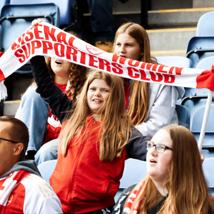







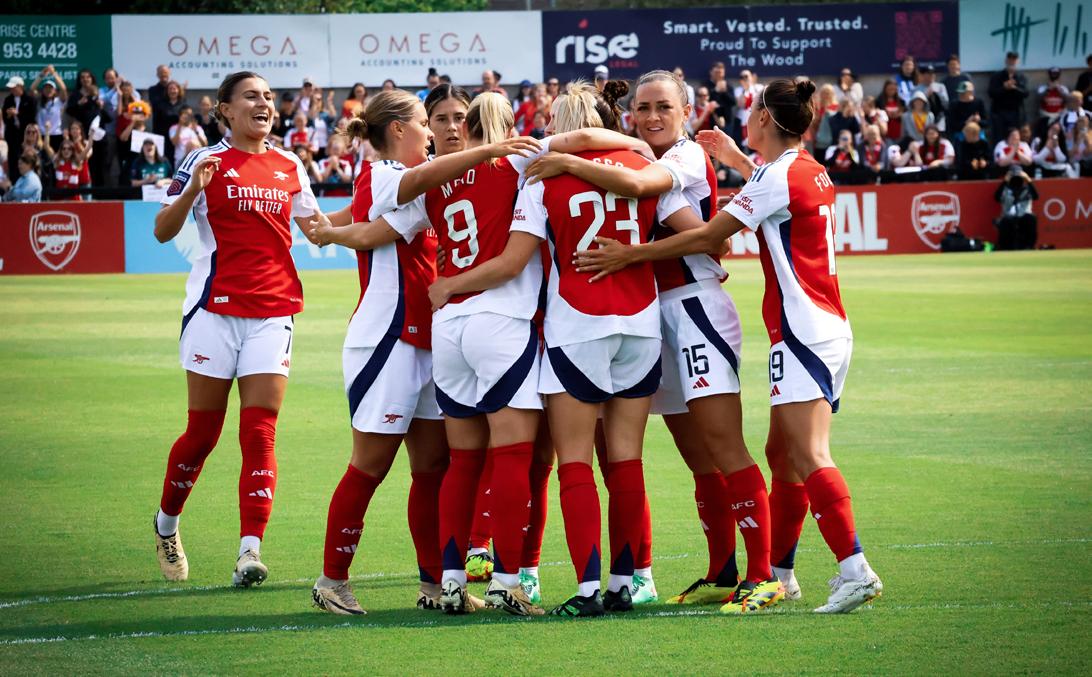




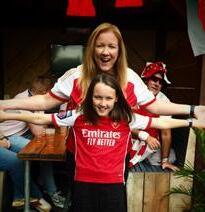
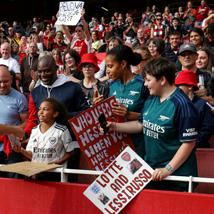



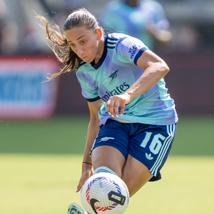


Hello, and welcome to our first digital-only Gooner Fanzine for the 2024-25 season, dedicated solely to all things related to Arsenal Women FC, and the women’s game.
We’ve been busy burning the midnight oil to get this digital edition over the line, and we are really excited about sharing such excellent, high quality work from such outstanding Arsenal writers, photographers and creatives with you.
First of all, I have to say a massive thank you to two very talented people, our Gooner Fanzine production genius, Serge Braga-Mullin, for his hard work and top-notch professionalism in helping to pull this issue together. Likewise, our brilliant editor of the women’s issue, Freddie Cardy, who has assembled such a superb squad, that we hope you will enjoy.
I would also like to thank those who have backed this project, without whose support we simply couldn’t publish, including Richard Smith and AISA, as well as Raymond James Hitchin, AST, and Jeremy Bradley’s JB Utilities, specialists in saving businesses money on their electricity and gas.
I’d also like to say a big thank you to everyone who has contributed to this issue, including Daisy Goodhand, Claudia Loy, Jamie Spangher, Laura Howard, Lily Young, Emily Herbert, Nancy Gillen, Liberty Simons, Lumi Lehmuskallio, Joseph Rosedon, Sophie Puodzius, Suzy Lycett, Sarah Pollard and Ruth Beck, as well as Freddie of course – all terrific writers, journalists and broadcasters, with such exciting futures, so please do keep an eye out for their work on other platforms too.
I’d also like to point you in the direction of the incredible sports photographer Suzy Lycett, who we’re delighted to say is now covering Arsenal Women matches for the Gooner Fanzine. We’re delighted to showcase a stunning selection of Suzy’s work on this platform, so please look out for her work with the Gooner in this issue, as well as over the course of this season, as well as on her instagram page (@boodlepim).


Layth Yousif @laythy29

I’d also like to tip our hat to all our wonderful readers, without who there wouldn’t be such a large, and ever-growing audience for our work. My youngest daughter Josie and myself went to the Leicester away WSL game to support the Gunners, and the incredible passion, loyalty, knowledge, good humour and allround tremendous backing for AWFC was amazing to see. Long may it continue.
Finally, I’d like to say a massive thank you to my wonderful partner Faye, without whose love and support I simply couldn’t continue to keep pushing the Gooner Fanzine forward. Please do watch this space, as we have big plans for our humble publication on Arsenal Women.
Everyone associated with our digital version of the Gooner Fanzine dedicated to Arsenal Women hopes that you enjoy this issue as much as we did when putting it together.
So, as we make clear on Sarah Pollard brilliant front cover, that you can also collect as a picture card, it’s now time for Jonas Eidevall to deliver. It’s over to you now Jonas…
Come on you Gunners
Layth, editor-in-chief @laythy29
If
would like




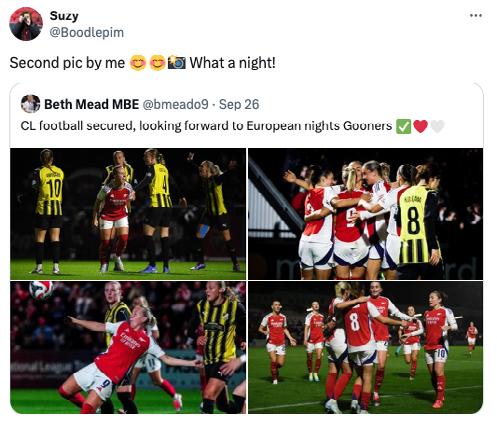


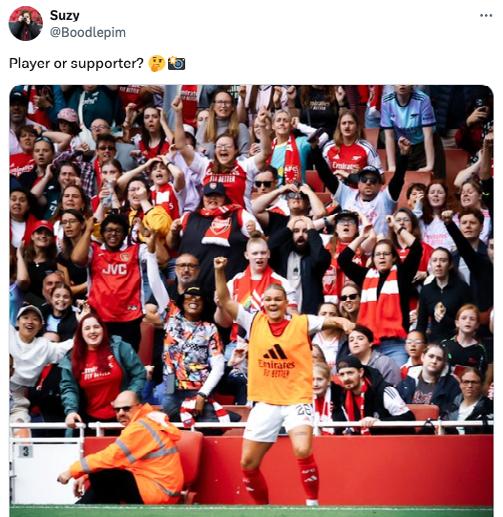
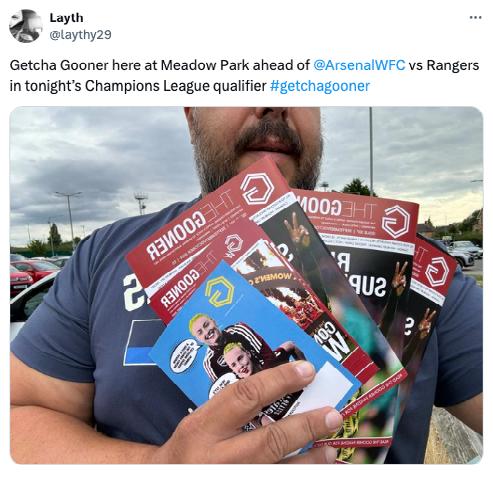







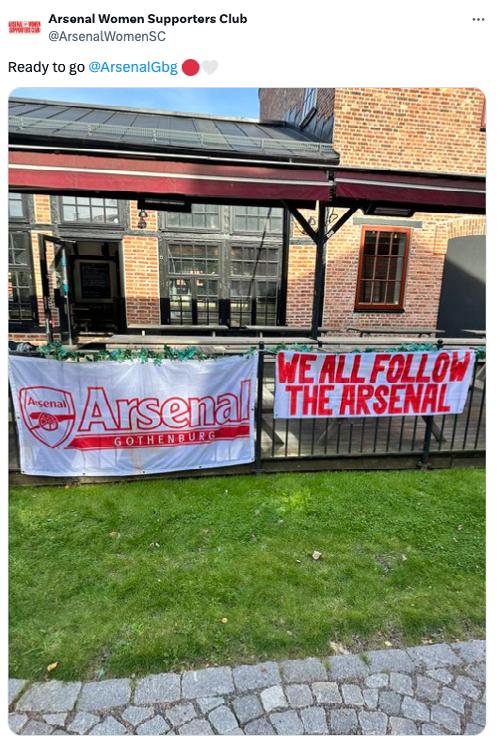
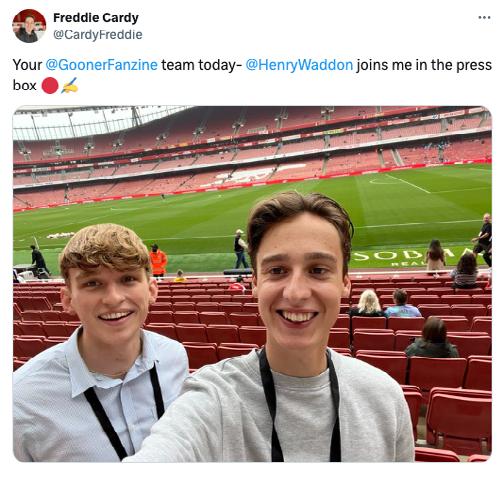











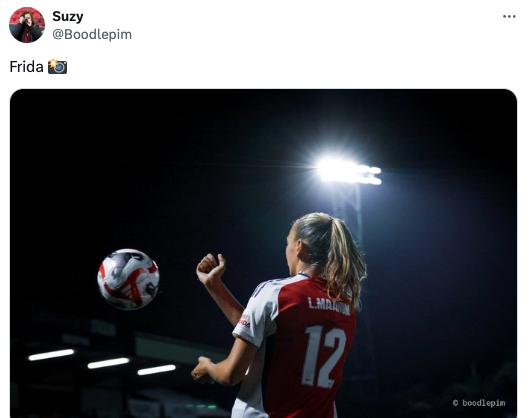

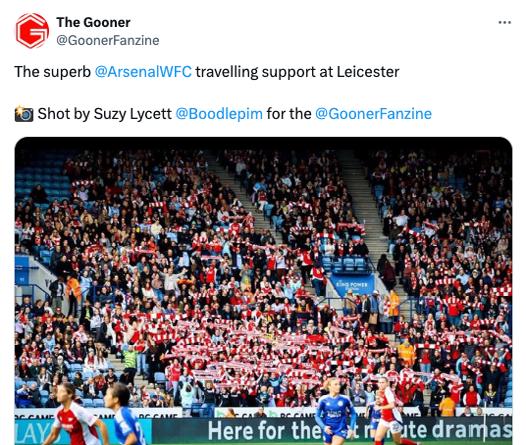










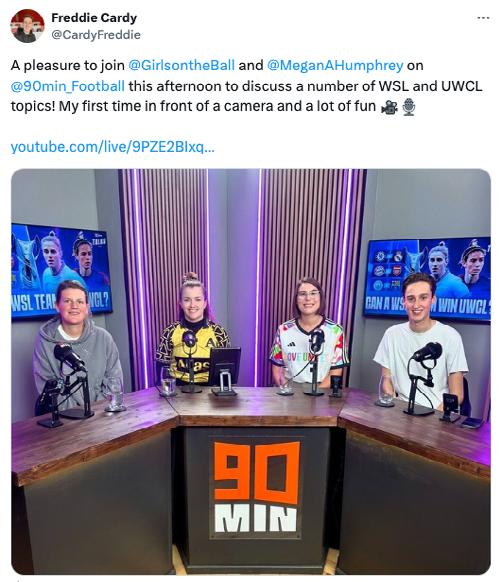



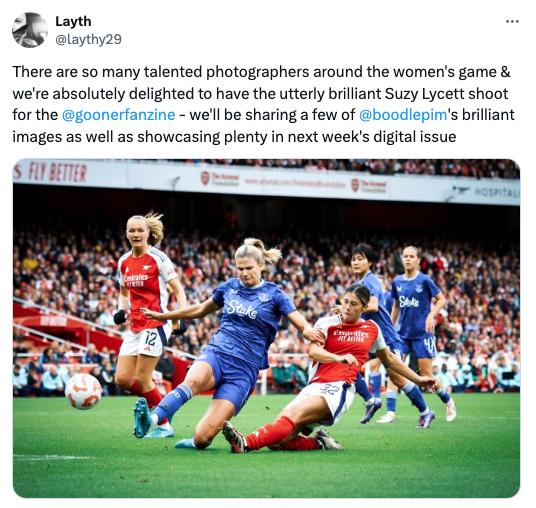
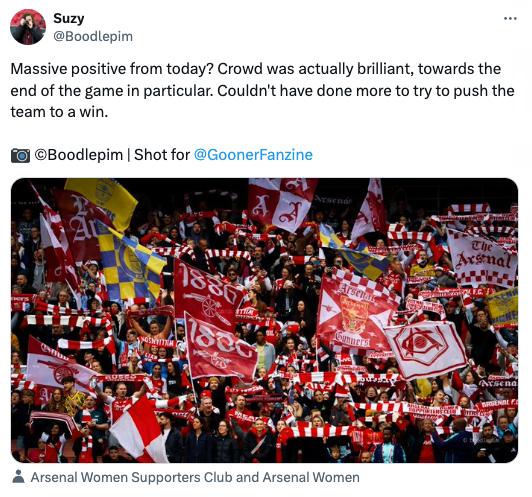
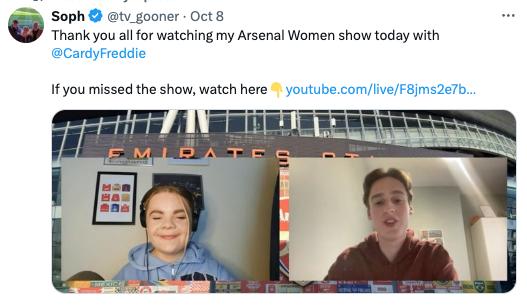




Here’s Richard Smith from AISA to explain the purpose and benefits of supporters clubs
Did you have trouble reading the teams on the big screens inside the stadium for the first few matches this season?
For many of the crowd not sitting close to them, or without benefit of a telescope or the vision of Superman, the new, thin font was practically unreadable.
Supporters asked us at AISA, ‘What’s going on?’ We raised it with the club and for the next match, we were pleased to see the previous, legible font was restored.
Now we can’t claim it was just us that instigated the changes. Other fans will probably have been in touch with the club – and the people responsible might also have realised, too. But change there was.
So, while we can’t claim sole credit, either for these and other improvements since then, we have been at the forefront of discussing and debating with the club directly, concerns of match-day spectators.
Back in 2021, those discussions included the size of bags permitted to be brought into the stadium. A maximum size of A5-size for a bag had just been set. That’s the merely size of the printed Gooner.
In a meeting, we pointed out that the minutes were being recorded on a laptop that wouldn’t be allowed in – hopeless if you were a supporter coming straight from work.
Within days, the permitted size had been increased to A4/rucksacks.
We’ve also successfully raised day-to-day issues that affect the matchday supporter, like improving access and entry to the stadium, signage outside the stadium, stewarding, general deterioration of the stadium’s condition,





Richard Smith @AISA_Arsenal
and ticketing and website anomalies… amongst many! Of course, there’s much else supporters’ clubs like AISA do, from organising events with former players and club insiders to discussions with the owners about the strategy and direction of the club.
But it’s often on matchdays that our impact may be most noticeable if not widely recognised by many.
The latest issue has been the sound system. It’s long been a complaint from AISA members that interviews are inaudible, and we’ve had many discussions with the stadium management as they sought to find a solution. But this season, the problem has changed. Depending on where you sit, it can be deafeningly loud.
At the Brighton men’s Premier League match, an average of 98.9 decibels was recorded in the East Stand, with a peak of 108.6db. This is described as ‘extremely loud’ in official documentation and, without earplugs, 90 seconds at that higher level can cause ear damage. Even the average – that equates to a circular saw – makes any kind of conversation between supporters impossible.
AISA has been part of a group keen to improve the atmosphere in the stadium, but ear-spitting volumes have not been part of the recommendations.
The club has acknowledged our concerns and has responded, saying, ‘This is currently under review with sound engineers, and we hope any necessary adjustments can be made. before the next match.’
Hopefully, by the time you are reading this, those adjustments will have been carried out, and your ears will not have been assailed at the most recent matches!

But what does this all actually mean to match-going supporters?
It signals that the club is prepared to listen to supporters’ concerns and – more than listen –welcomes them and actively responds to them, which is a huge step forward on how it seemed to be at the start of this decade.
And it demonstrates how important that supporters use their voice. Anyone can contact the club with individual moans, but it helps when issues are raised with the weight of an organisation like AISA that is trusted and known to represent a large number of people. Being a part of it ensures your voice is heard and ours continues to be truly representative, and is strong, respected and can help lead to change. It benefits both the club and you.
With your help and your membership, that’s what supporters’ clubs like AISA can do for you!
See page 63 for details on how to join AISA

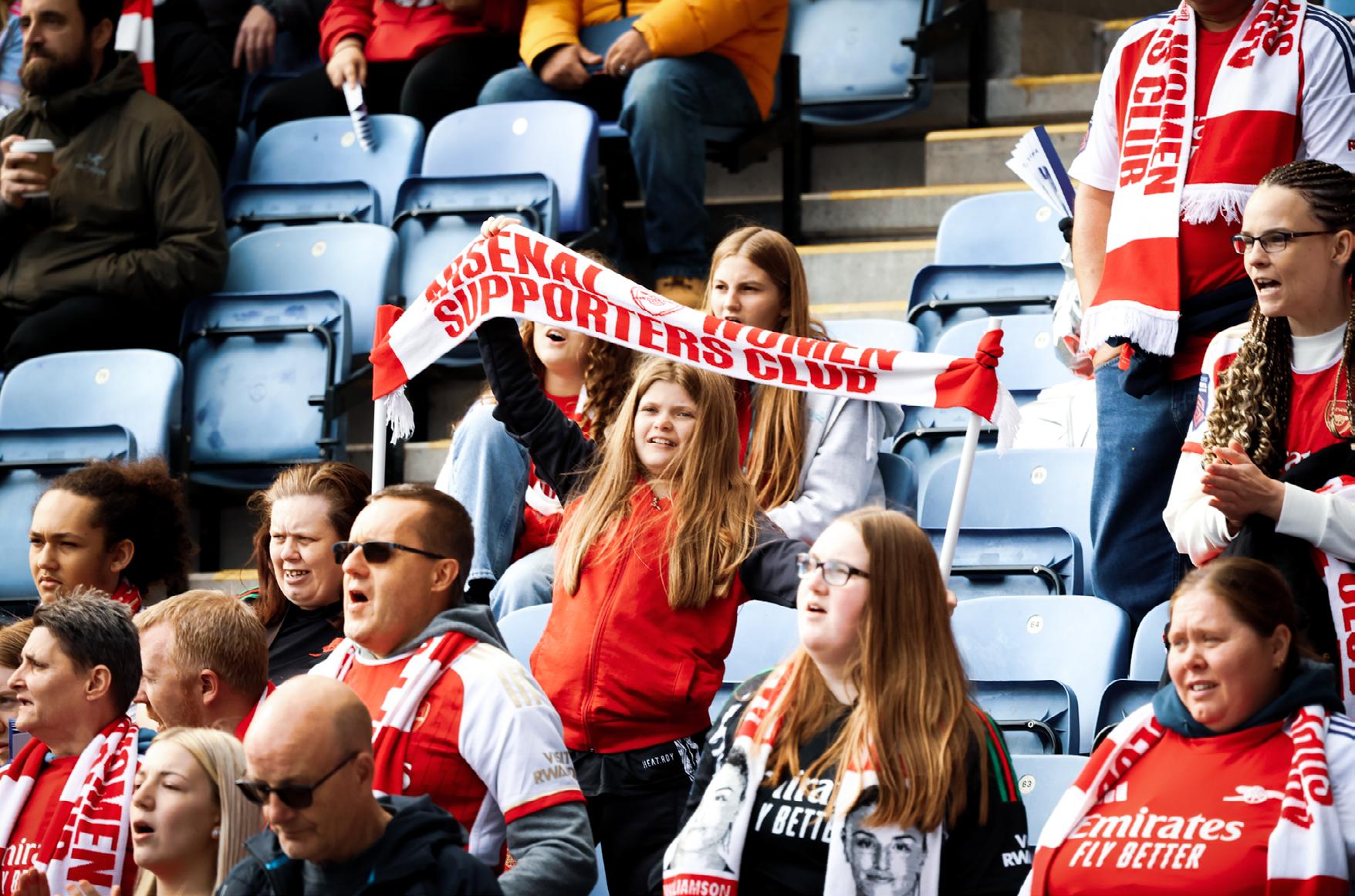




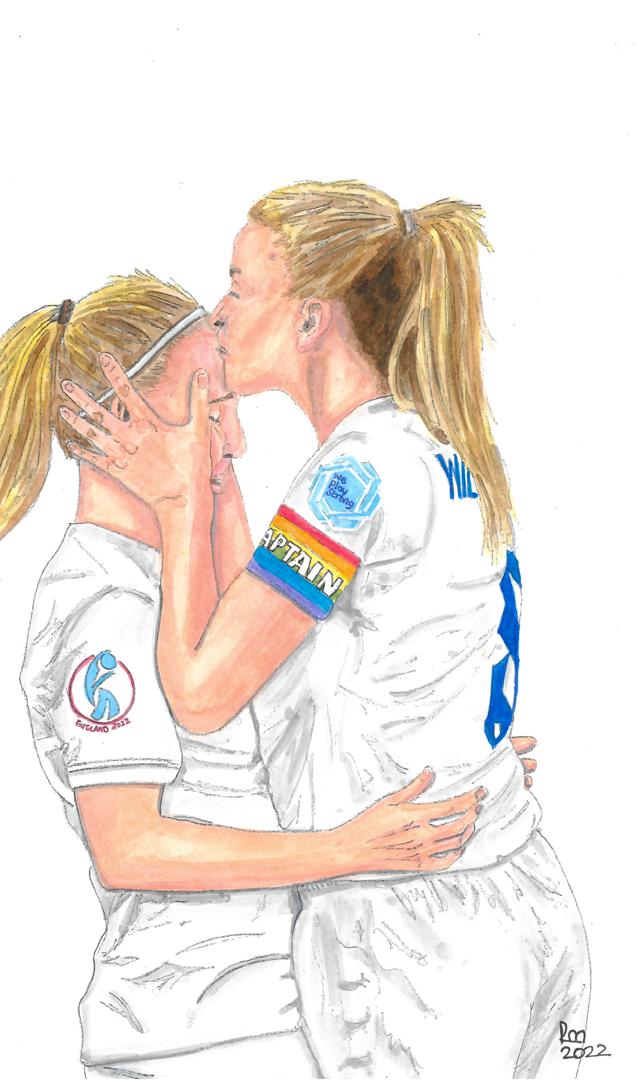




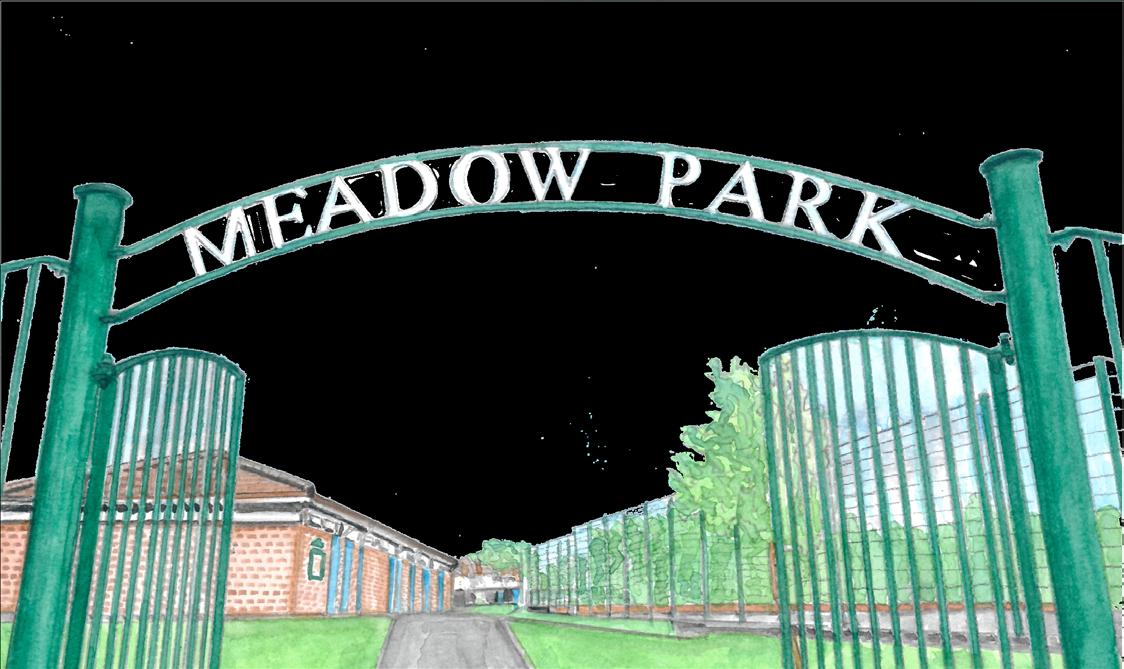




Press box diaries: 2024-25 gets underway
Saturday, August 31:
Southampton v Arsenal
The Titanic began its maiden (and final) voyage from Southampton, so let’s hope Arsenal’s season doesn’t take a similar trajectory after the Gunners began their domestic 2023-24 campaign with a friendly at St Mary’s Stadium.
Arsenal’s final pre-season outing was a successful one, as Kyra Cooney-Cross found the top corner with an inch-perfect finish before a brace from Laia Codina as Viv Lia’s set-pieces caused chaos.
Jonas Eidevall was surprised to see so many Arsenal fans make the journey down and told me that it added some extra pressure on his side to win the friendly, as the head coach looked back on a good pre-season for his side, one that included two games in Washington D.C.
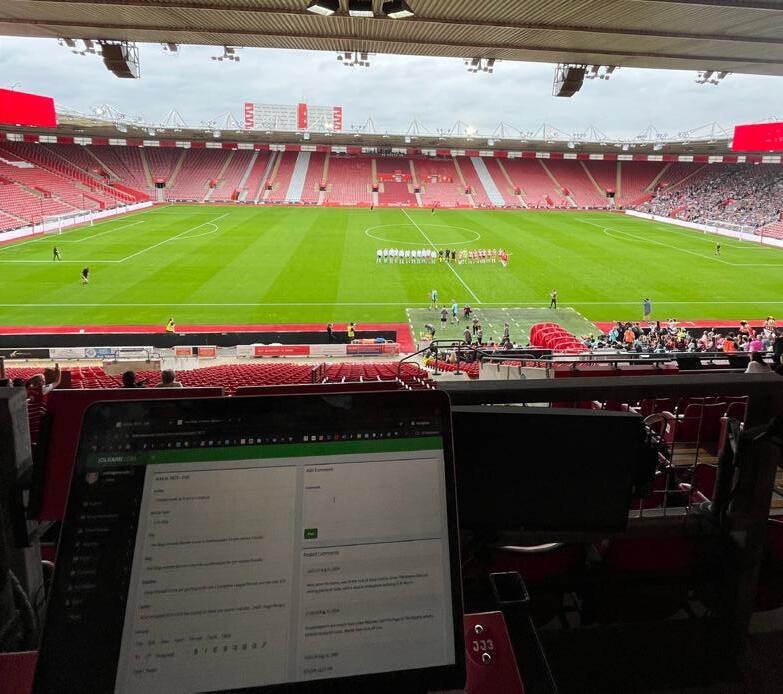



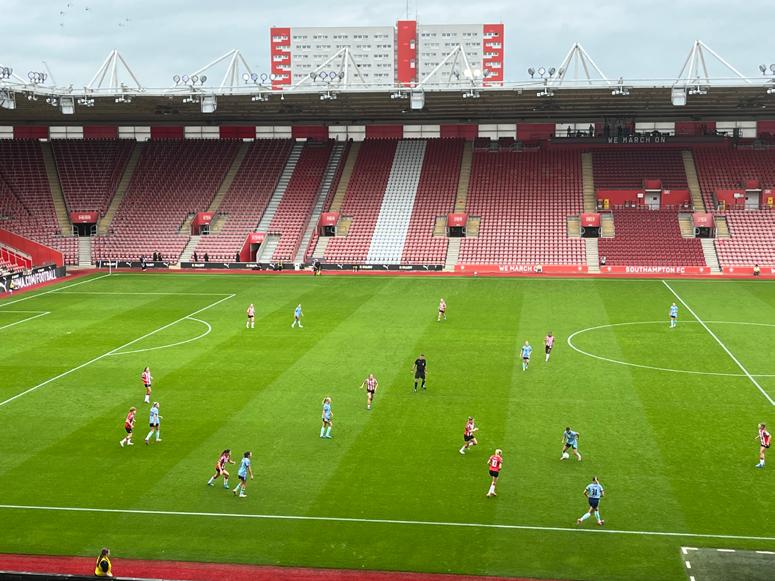
Wednesday, September 4: Atletico Madrid v Rosenborg
It was good to be back at Meadow Park for a rare double-header, as Arsenal hosted a four-team mini tournament.
The winner would progress into the second round of Champions League qualifying.
This kicked off with a truly dramatic encounter between Atletico Madrid and Norwegian side Rosenborg, who took the game to extra time with a 91st minute equaliser before their Spanish competitors forced penalties in the 120th minute after Rosenborg had gone 2-1 up.
Rosenborg, managed by former Stevenage and AFC Wimbledon striker Robin Shroot, would win the penalty shootout thanks to two saves by goalkeeper Rugile Rulyte, sparking scenes of





jubilation from four loyal Norwegian supporters in the North Bank.
September 4:
After a long three hours to kill in Borehamwood that consisted of thinking of a name (Kühl Runnings) and a team itself (featuring both Alessia Russo and Rosa Kafaji upfront) for the excellent Fantasy WSL game, and enjoying a cup of tea, it was back to Meadow Park to see Arsenal hit Rangers for six.
Having held Arsenal to just a one-goal deficit for almost an hour, Rangers were victims of the footballing gods when goalkeeper Jenna Fife was told off for time-wasting, before promptly conceding twice in the space of only two minutes as the game was quickly taken out of the Glaswegians’ hands.
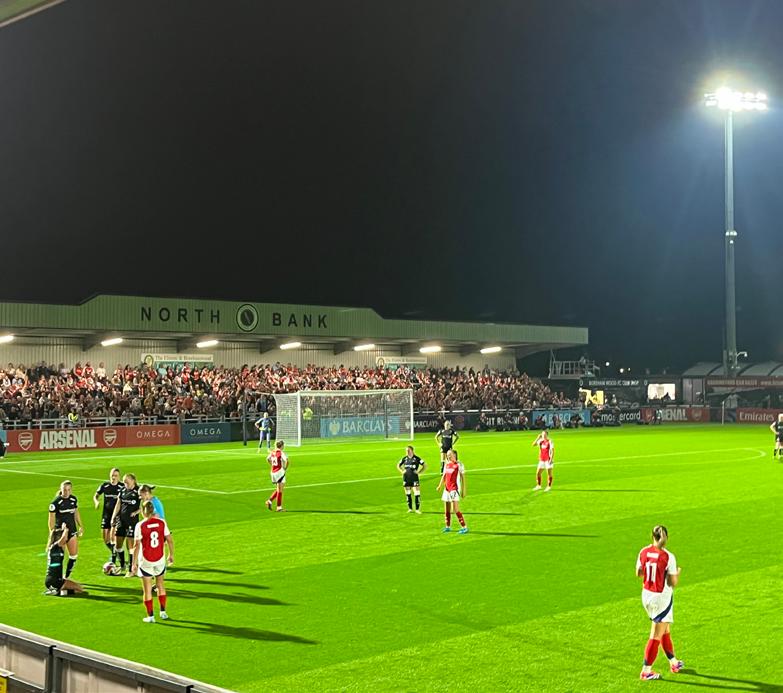


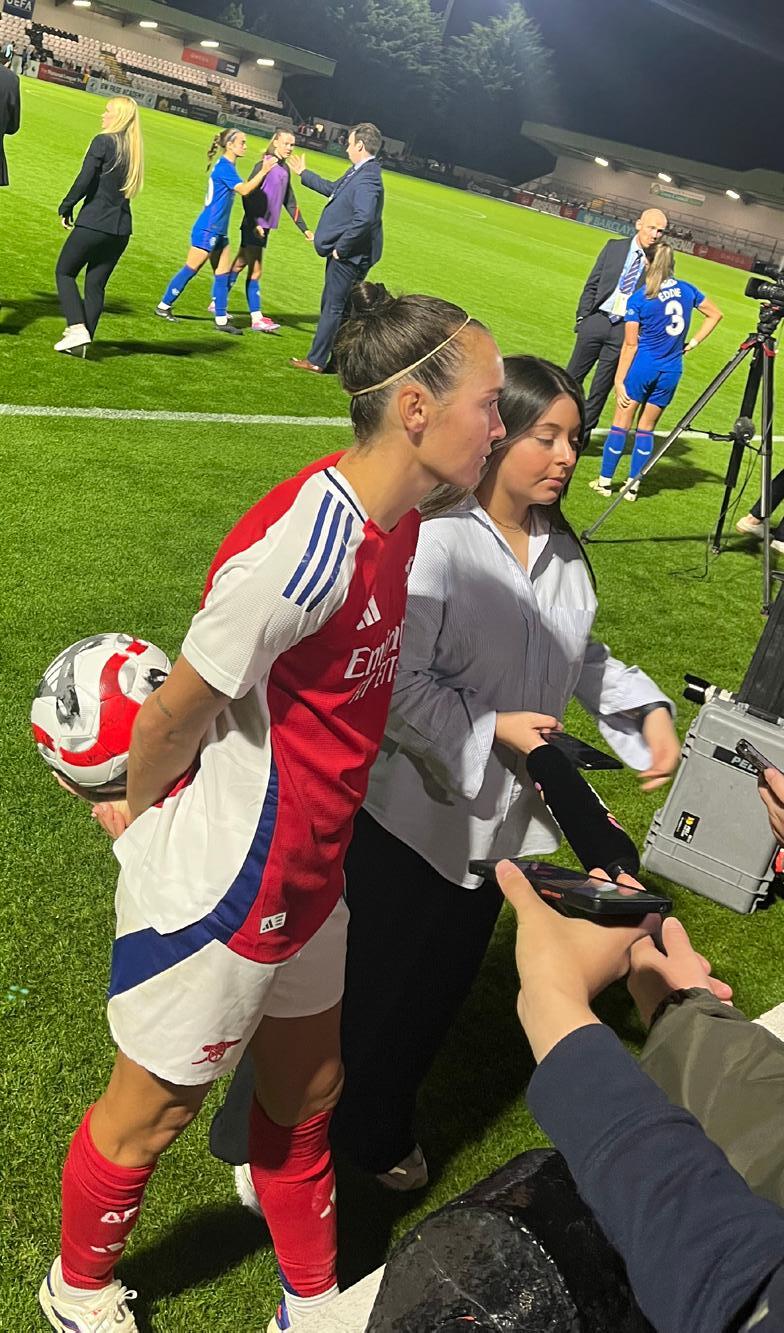










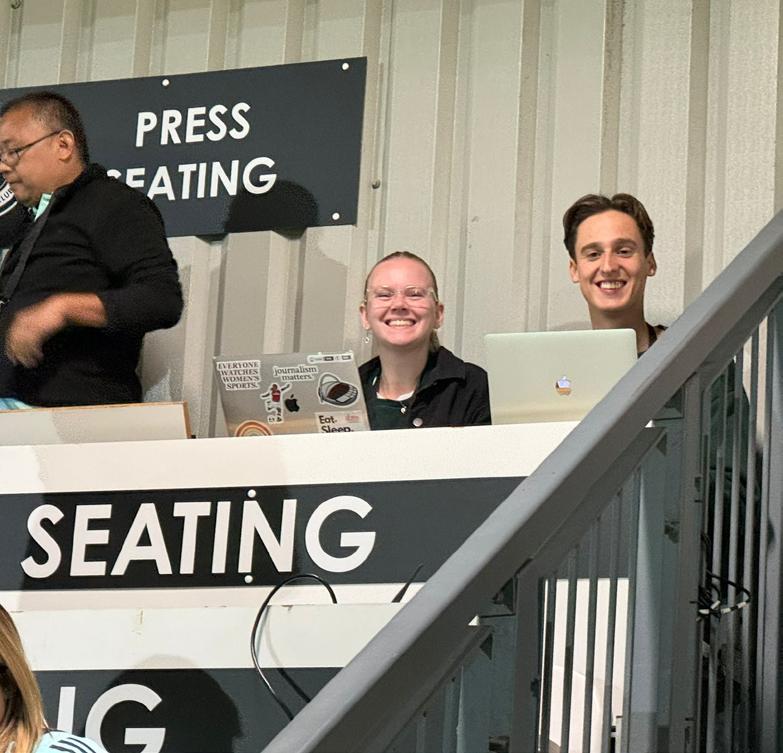
However, the night belonged to Caitlin Foord, who netted four times from the right-wing, a combination of very fine finishing and some high quality service from the likes of Mariona Caldentey and Katie McCabe.
7:
Another evening kick-off gave me enough time to watch the first half of my beloved Hitchin Town before heading down to Meadow Park with the Gooner’s Daisy Goodhand and the designer of this front cover, Sarah Pollard!
Despite the short turnaround between games, Jonas Eidevall named an unchanged side, as this was the exact stage of qualifying that saw Arsenal


knocked out by Paris FC in the Swedish city of Linkoping last year.
Yes, there were some late nerves as Arsenal failed to capitalise on 29 shots on goal, but the important thing was that Frida Maanum’s went in after 19 minutes to take Arsenal through to the second qualifying round. Even more importantly, this was the night where Mariona Caldentey’s brilliant ‘Twist and Shout’ chant really made the big time. We were grooving in the press box.
Wednesday, September 18: BK
I’ve written about my excellent trip to Gothenburg elsewhere in this very Fanzine, so I guess I’ll have to touch on the game itself. Arsenal were sluggish and slow in attack and were hit on the counterattack to lose 1-0 to Hacken at the Bravida Arena, hitting the crossbar twice in the process.
The Gunners were keen to point out that it was only half-time in the tie, and Kim Little’s prediction (speaking to me in the mixed zone after the game) that they would turn the game around at home in the second leg, came to fruition.
I did feel for those travelling Arsenal fans though, many of whom had come from all over Sweden and various other places, not just London, to be in Gothenburg. The hundreds of supporters who had made the journey deserve just as much praise as the tens of thousands who regularly pack out Emirates Stadium- the definition of genuine commitment.

Sunday, September 22:
Lesson learnt: covering back-to-back lunchtime kick-offs after a far too enjoyable Friday night is not enjoyable. My weekend consisted of the Derbyshire County Cricket Club (my summer internship) awards dinner, Chesterfield versus Cheltenham in League Two, and then a blockbuster WSL game between Arsenal and Manchester City.
After the fun of Friday and a delayed three-hour train journey down from Chesterfield, I was pleased to have the company of Henry Waddon in the press box, with Henry focusing on player ratings and a ‘Three Things’ piece whilst I produced the live blog and post-match reaction.






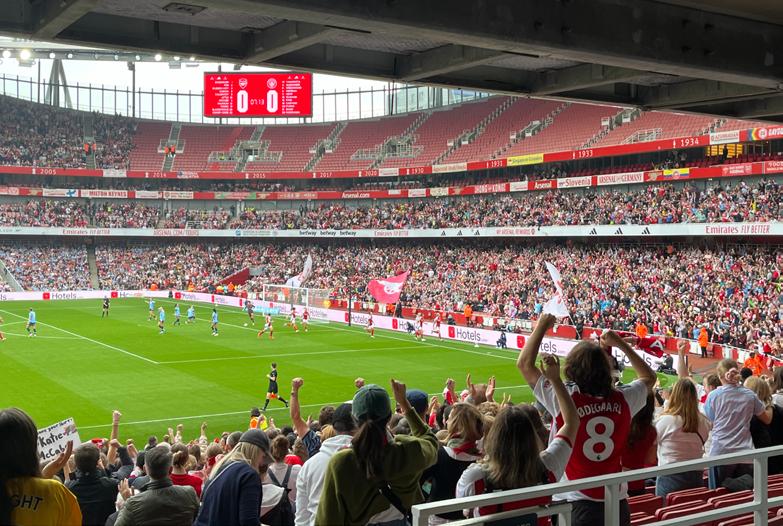

Kudos to Henry, who smashed it, and I hope enjoyed every minute of being at the Emirates! It’s always a real privilege to be there. Arsenal missed some golden chances and were held to a 2-2 draw, with Vivianne Miedema scoring on her return and Beth Mead netting a late equaliser.
Sunday, September 29: Leicester City v Arsenal
How do I write three paragraphs on this game? It was not a classic at the King Power Stadium, with Arsenal fatigued from their crucial second leg win over Hacken a few days earlier.
Frida Maanum impressively scored her third goal in successive games after Alessia Russo latched on to a misplaced back pass, but Arsenal were literally saved by Daphne van Domselaar, who pulled off a number of top-quality stops to keep Leicester at bay.
It was great to feature on BBC Radio Leicester after full-time, having also joined the Gooner’s Emily Herbert on BBC Radio London’s all-new Women’s Football Show earlier in the week.
Wednesday, October 2: 90min Talks
My first time in front of a camera, joining the 90min.com panel for their live YouTube show, recorded on set in London! It was a real privilege to be invited and to join some brilliant women’s football content creators to discuss a wide ranging number of topics.
For someone who has done six years of radio as well as writing, switching to the bright lights and cameras of a swanky London studio was an incredibly valuable experience.
I was able to share my thoughts on Arsenal’s difficult Champions League group, scheduling issues and the Gunners’ start to the WSL season, and you can watch the full show on YouTube.






Borehamwood

InClaudia Loy @Clauds93

2017, Arsenal Women agreed a 10-year deal for Boreham Wood’s Meadow Park to be their home ground.
At the time, it was seen as a positive step and a commitment to improving the facilities at the ground over the coming years. They are gradually doing this, but how much longer will it even be necessary?
Fast forward to 2024 and Arsenal are rapidly outgrowing its capacity of 4,500. I think for us fans, an interesting question is ‘which home do you prefer?’ With three years left on the deal, it seems like we currently have the best of both worlds before moving to Emirates Stadium






full-time. We can grow the fan base and have games on the big stage. What’s not to love?
For the growth of the game, it’s important to have the Emirates as our main home, so it’s exciting that the club has made this step.
It’s a statement and a bit of a pinch-me moment for us fans. We’re leading the way in women’s football as a club.
Getting to watch the team play at the Emirates is amazing and it shows how much the club values its women’s team, as well as how commercially viable it is.

After the end of games at Meadow Park it does start to feel like a bit of a meet and greet.
Chelsea Women have recently ended the opportunity for fans to meet players after the game, and I don’t know whether Arsenal will follow suit.
I can see that it’s becoming too much of an expectation for some fans. The Emirates automatically removes this problem because fans are much further away from the players.
It’s great to meet players, but it should never be expected, and their boundaries






should always be respected. Sadly, they aren’t, because some players are screamed at by fans, which I imagine can be intimidating. Chelsea have cited safety concerns.
The rush to the pitch after the game may gradually disappear when people realise they won’t get to meet the players, and the same thing goes for trying in the car park.
Despite this, Meadow Park will always feel like home, because it has been for so long. I’ve seen so many people say that they love the atmosphere there, and I agree. Being a smaller ground, it’s a lot easier to get chants going and



every time I’ve been there, I’ve had so much fun. I’ve enjoyed being so close to the pitch and chanting in the North Bank with everyone.
You can see everything and even hear everything. Every tackle, every goal, every shot, communication between players. It feels more real somehow, and the players feel more human. It’s how football used to be.
I don’t think we’re ready to leave it just yet. Long live Meadow Park. Luckily, we have at least three more years of it!
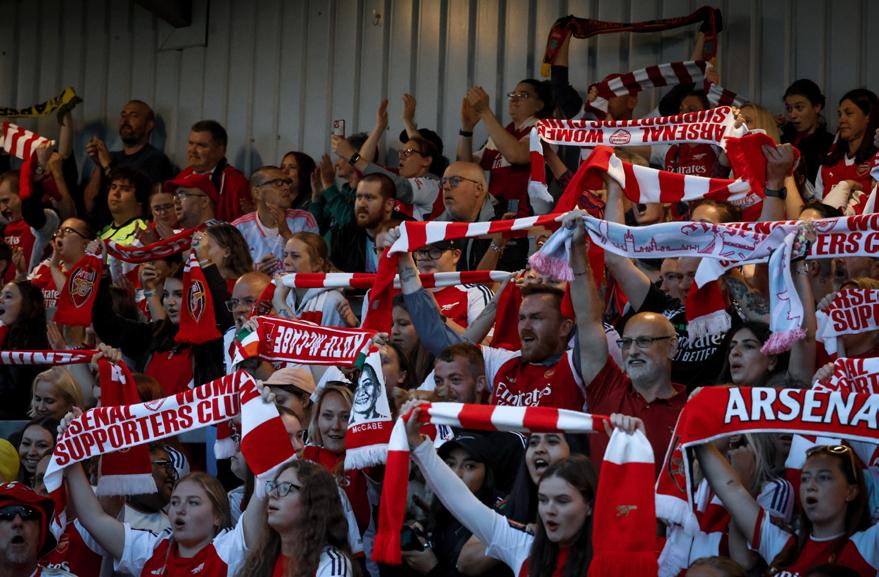







Lastseason, Arsenal’s performances were a mixed bag of achievements and disappointments under Jonas Eidevall.
Although they secured the League Cup, their third-place Women’s Super League finish fell short of expectations, ending the campaign five points behind Chelsea and Manchester City.
An early exit in the UEFA Champions League qualifiers against Paris FC was particularly disappointing- a significant setback for a team with European pedigree and ambitions.
Additionally, Arsenal’s FA Cup campaign concluded in the fifth round against Manchester City, preventing yet another opportunity for much needed silverware.

Throughout the season, Arsenal struggled with inconsistent form, missing out on the silverware that their squad’s potential suggested they could achieve.
Eidevall, who was appointed in 2021, continues to face mounting pressure to translate his vision into consistent success, with fans and the club eager for more silverware.
While cup triumphs are very valuable, the focus must shift towards achieving a more consistent and dominant presence across all competitions to truly reflect Arsenal’s elite status and ambitions.
Since Eidevall’s appointment, his tactics have evolved, and the current squad appears to be





the strongest and most depth-rich group of players at his disposal.
Last season, his standout tactics were evident, but there were also notable weaknesses that opponents exploited, leading to some humiliating defeats and exits from competitions.
Arsenal’s squad has since undergone significant evolution, marked by a series of strategic signings.
The arrival of Daphne van Domselaar, a talented Dutch goalkeeper, introduces healthy competition for the number one spot with Manuela Zinsberger.
Mariona Caldentey, a proven winner from Barcelona, will certainly enhance the team’s attacking prowess.
Her ability to deliver precise crosses and link up play from the wing adds a dynamic edge to Arsenal’s offensive options. Her experience and skill set make her a valuable asset in breaking
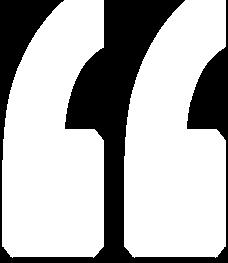
Last season, Arsenal’s approach in possession was marked by highintensity play and immediate pressure on opponents
down tough defences and providing the creative spark needed in critical matches.
Rosa Kafaji brings a fresh, impactful dimension to the squad in the number 10 role. Known for her creativity, and knack for driving at players, Kafaji could offer the team a new level of unpredictability and attacking flair.
Last season, Arsenal’s approach in possession was marked by high-intensity play






and immediate pressure on opponents. They effectively utilised their strong ball-playing centre-backs, particularly Leah Williamson and Lotte Wubben-Moy, to play through the lines.
Eidevall’s side focused on wide play, aiming to deliver crosses into the box, though they often struggled with accuracy and had too few players in the area.
Arsenal’s wingers thrived in one-on-one situations and benefited from fullbacks making overlapping runs. Arsenal’s striker would drop deep to assist in build-up play, creating space by drawing defenders out.
Arsenal found it challenging to penetrate against teams operating in a low block. Decision-making and execution in the final third were inconsistent, leading to missed chances and a low conversion rate.
Asenal’s defensive strategy involved pressing and marking key opponents closely, effectively denying them time on the ball, as seen in their



4-1 win over Chelsea where they neutralised Lauren James.
They maintained defensive solidity by having one fullback stay back while the other pushed forward, and players like Lia Walti, despite injury, were crucial in supporting the defence.
Wingers, including Beth Mead and Caitlin Foord, dropped deep to close down space on the flanks.
Arsenal improved their set-piece defence by increasing the number of players back to prevent goals from these situations.
They played a high defensive line but needed to be careful with opponents exploiting space behind them.
Despite having the most set-pieces in the league, Arsenal have singularly failed to capitalise on them, a key area they plan to address with the arrival of a new set-piece coach in Chris Bradley. They must begin

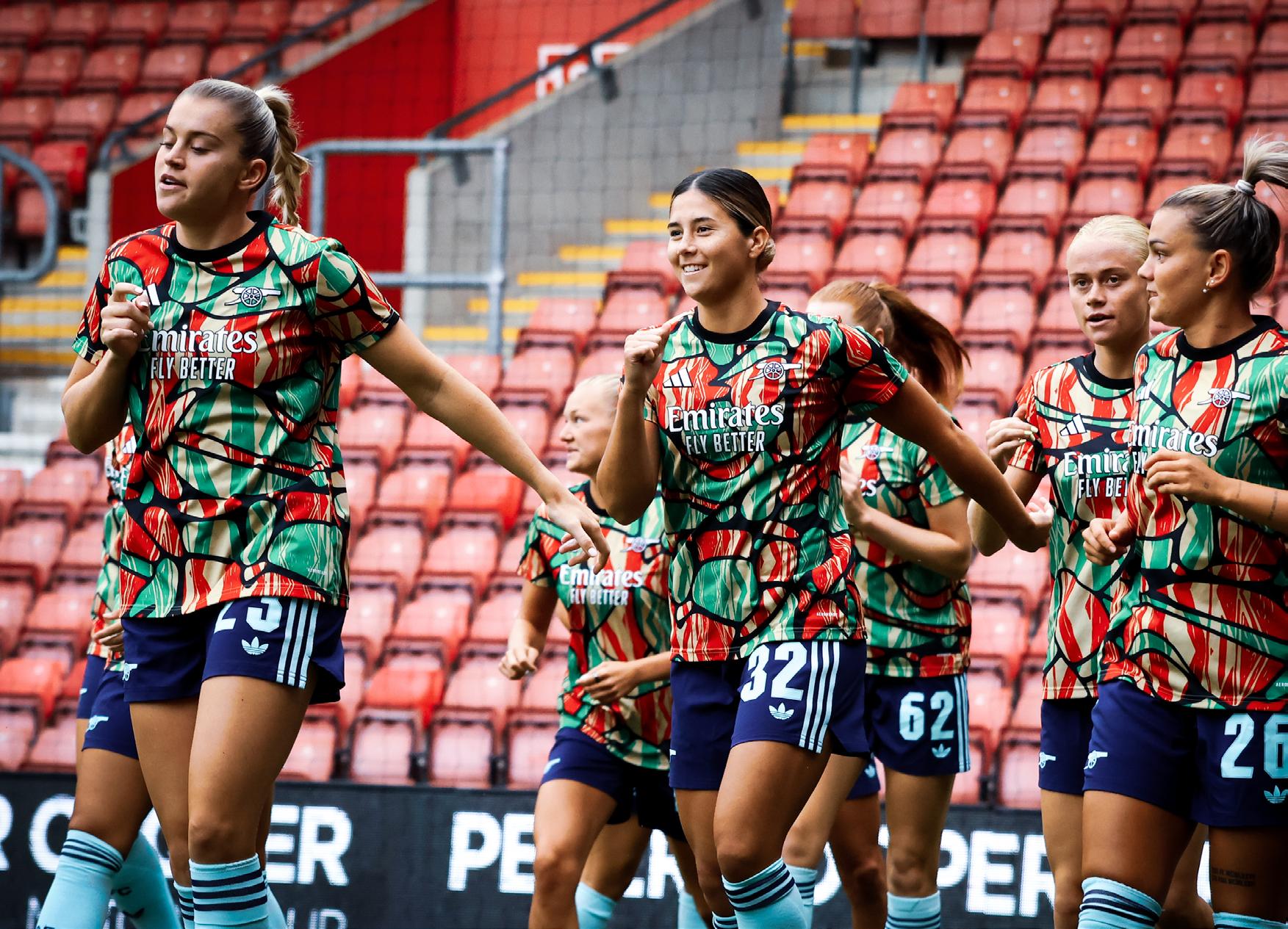
to better utilise set-pieces as a scoring opportunity, which could significantly improve their overall goal tally and match outcomes.
Arsenal’s difficulty in breaking down teams that play with a low block was a recurring issue last season. Teams adopting this strategy tend to deploy a compact, organised defensive setup, which can stifle Arsenal’s attacking flow and limit their ability to create high-quality goalscoring chances.
The Gunners’ inability to break down these teams resulted in missed opportunities and dropped points in the WSL.
Arsenal need to develop much more effective ways to create opportunities against teams that sit deep.
This could involve improving their movement off the ball, employing more dynamic and varied attacking patterns, and ensuring that players can exploit small gaps in the opposition’s defence.
For Arsenal under Eidevall, success this season means more than just winning cups. It involves transforming into genuine title contenders- both in the WSL and in Europe.
The goal has always been to evolve into a squad that consistently competes at the highest level across all competitions, but this is the final opportunity to prove it.
This isn’t just about keeping Jonas Eidevall in charge; it’s about reinforcing Arsenal’s place as a top team in women’s football, just like they’ve always been.
They played a high defensive line but needed to be careful with opponents exploiting space behind them






Jamie Spangher’s on how the US collegiate system has helped to fuel the emerging generation of Arsenal greats
TheUSA has been a hub of emerging talent across sports for decades.
Some of the finest athletes in global sporting history have been born and bred in the US, before heading off to enter the American collegiate system when they come of age.
Soccer flourishes under the structural and punctually managed schooling system of the States, and the women’s game has seen some of its greatest stars pop out of the conveyor belt that is the US collegiate system- including the likes of Alex Morgan, Tobin Heath, Mia Hamm, and England’s own Lucy Bronze.
Though for young aspiring ballers in England, further education isn’t always an available option that arrives hand-in-hand with football development for emerging talent.
Clubs tend to nourish and scour their talent from academy programs, hand-picking the best of their very own to sign a professional contract the day that the young star turns 18.
The importance of the American collegiate system has become more prominent than you would imagine



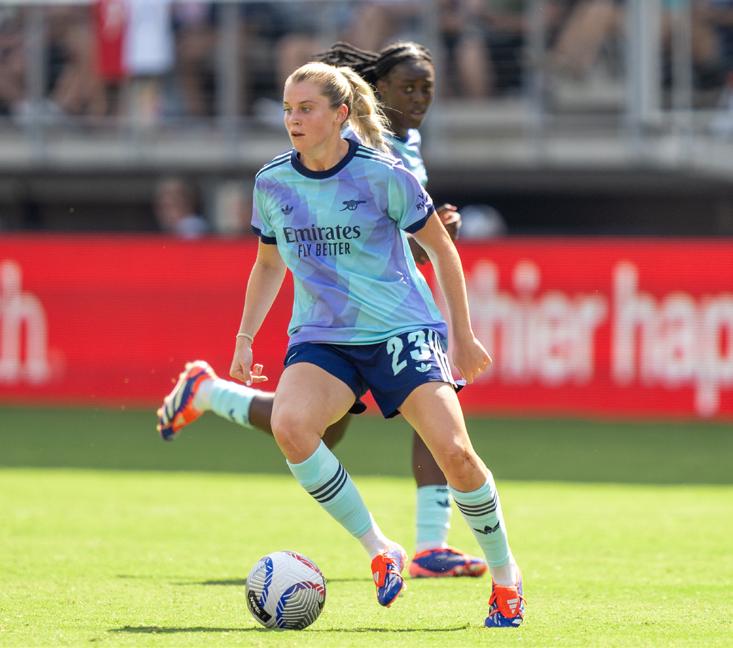
This can be said about Arsenal’s Leah Williamson, having joined the club at age eight.
Current young Arsenal players like Katie Reid, Vivienne Lia, Michelle Agyemang, Freya Godfrey- to only name a few- have all plied their trade in the red and white from a young age.
Despite the ever-present quality being developed in the academy system, for Arsenal, the importance of the American collegiate system has become more prominent than you would imagine.
‘One of our own’ Lotte Wubben-Moy headed stateside to sign a college contract with the University of North Carolina, before returning to England to pen her first professional deal.
Wubben-Moy would return home from the States in 2020, telling the Arsenal website upon return: “Within these past three years, I’ve really been able to find myself.”
She then continued, “I know that sounds cliche when you go to college but it’s something that not many youth professional





footballers get to do because they get thrown straight in there. I really think what I’ve been able to do while I’ve been out in the States, not just on the field but off the field, has been unique to me and unique to the girls that actually get the opportunity to do it.”
Wubben-Moy starred for the Tar Heels, but she wasn’t the only Englishwoman plying her trade in North Carolina.
England youth, and now international, teammate Alessia Russo would start alongside Wubben-Moy as the pair developed in the American system alongside each other.
Fast forward to 2023, and the two were starting and starring for Arsenal as mainstays in the Gunners starting eleven.
Speaking to Just Women’s Sports during the recent US pre-season tour, Alessia Russo expressed how valuable she found her time in the collegiate system:
“I loved my time at college. I just remember going out there quite young and naive, and




I thought that I’d throw myself into this new environment and experience. [It was] the best experience, and I think that you have to learn a different style of football, which was cool.”
Then came Emily Fox, an engine in the fullback position, finding her new home in North London after spending three years in the National Women’s Soccer League (NWSL) with Racing Louisville and North Carolina Courage.
Fox immediately flourished in England, flexing her muscles down the Gunners’ right side, working in tandem with Beth Mead, whilst proving rock-solid next to Leah Williamson.
As England continues to find their talent from the depths of the academy systems, Arsenal Women must also salute the USA collegiate system, and how it has worked to forge the present stars of the Gunners.
North Carolina are currently ranked number fifth in the NCAA (National Collegiate Athletics Association) rankings, and have been crowned NCAA Tournament Champions 21 times.

One of those occasions was back in 2019, with a team that starred Russo, Fox, and Wubben-Moy amongst their talent pool. All three of the now-Arsenal stars featured consistently for the Tar Heels, while Russo especially flexed her muscles, scoring 13 goals (including five braces) during the championship year, before being named the ‘Most Valuable Player of the ACC tournament’.
As Arsenal enter a new era of exciting and fresh talent leading the Gunners to hopeful success, credit should be given to the collegiate system and its role in creating the next generation of Arsenal stars.
Arsenal must also salute the USA collegiate system, and how it has worked to forge the present stars of the Gunners

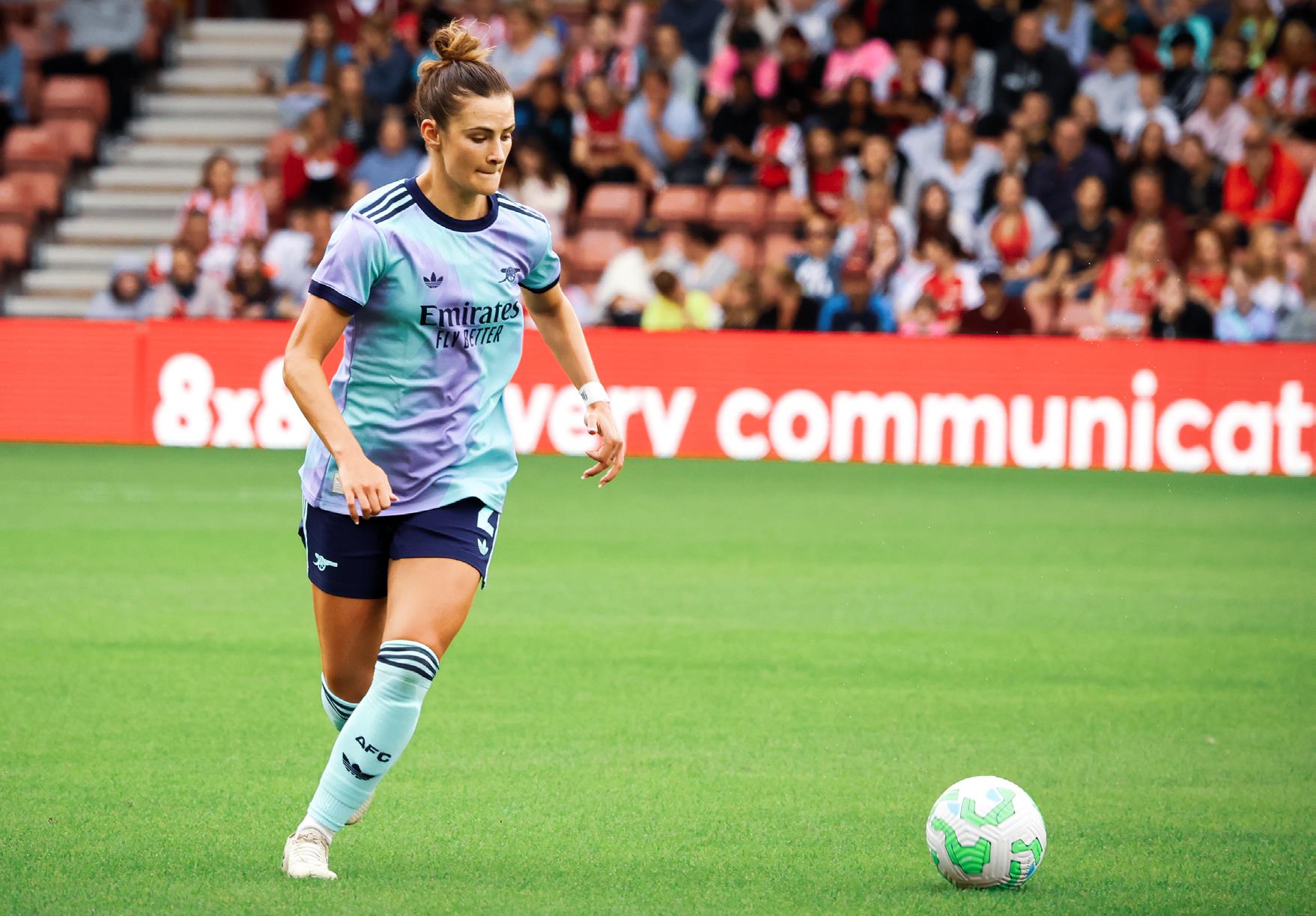





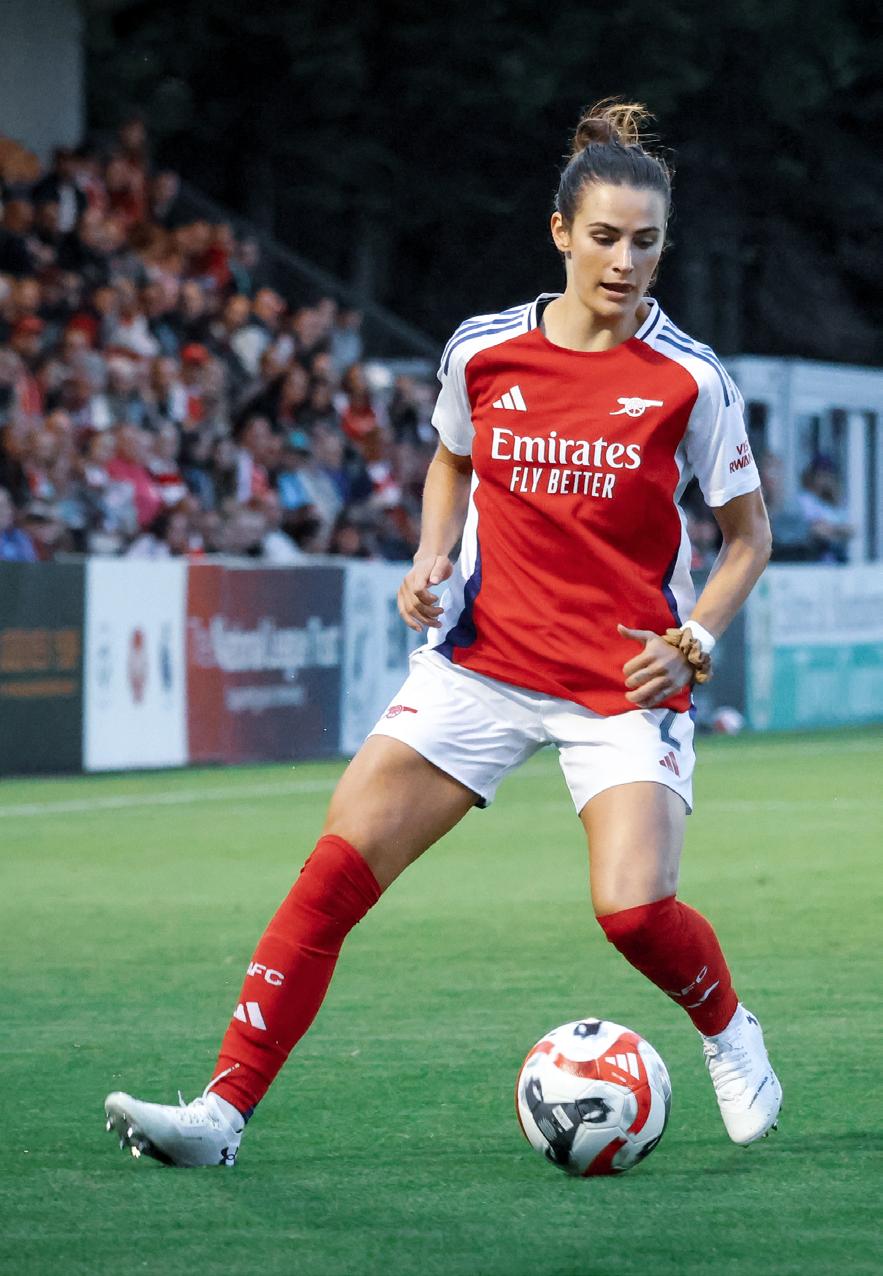
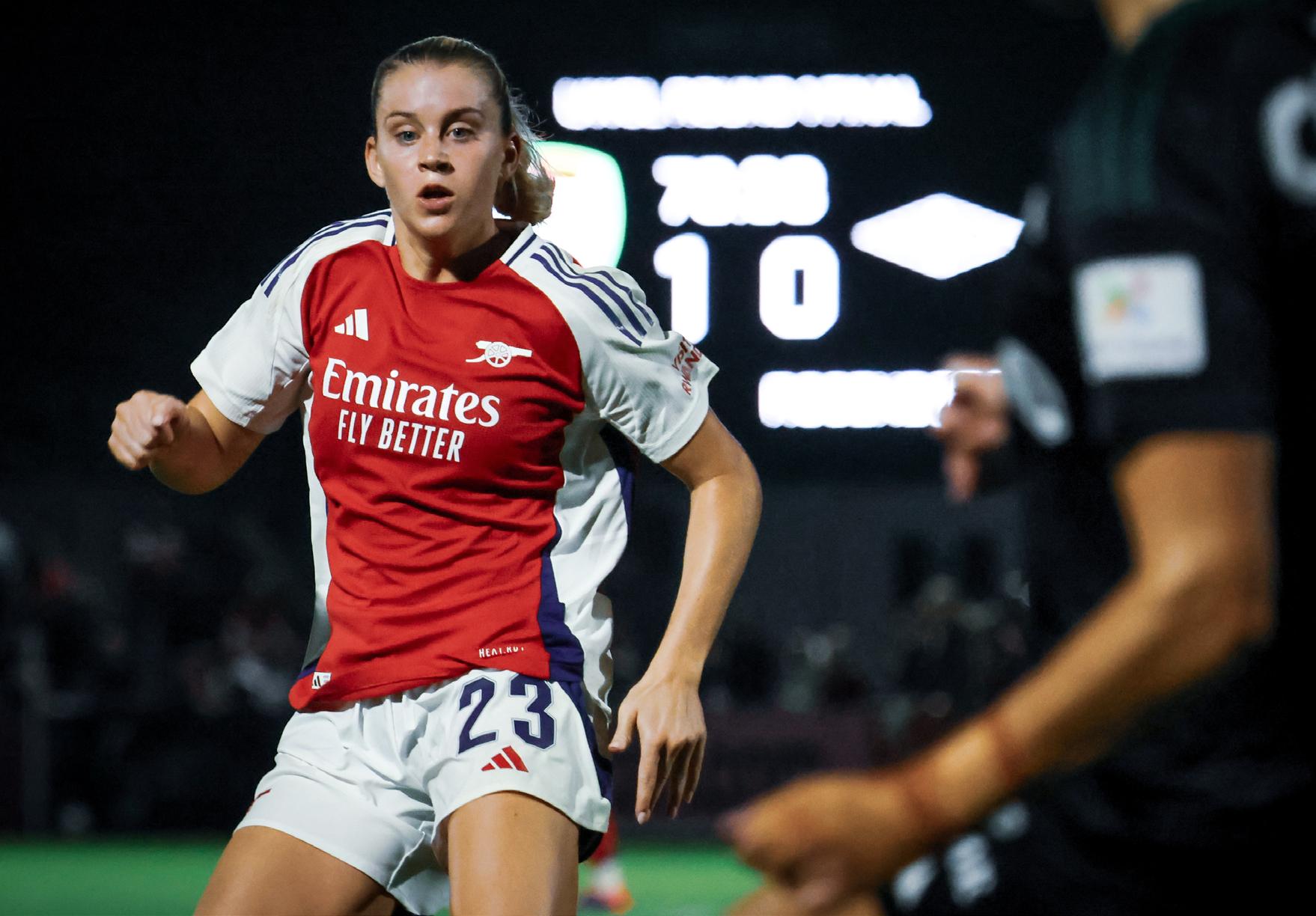





Laura Howard on why AWFC is like a religion
Supporting Arsenal, or any football team, is to put an unending faith in the actions of eleven players on a rectangle of hallowed turf in front of us.
They are eleven players (plus substitutes) who can make us sad, frustrated and angry all at the same time, or provide moments of joy and belonging when all else seems bad.






Laura Howard @laura_hwd
It seems neither plausible, nor sensible, that a Stina Blackstenius side-footed shot in Wolverhampton can shape our mood for the rest of the week. Yet it can and it does. It is almost as though, through the uncertainties that life throws at us, Arsenal and the community that comes with it can provide an escape. Sound familiar?
Religion and football have long been associated, whether it’s through terminology like Diego Maradona’s ‘hand of God’ or comparisons between the Father and the legendary Dennis Bergkamp.
We worship players, even idolise them ‘whatever the weather’.
That is not to say that football is a religion.
In fact, there is much to criticise about religion, and football fandom for that matter, but not always the same parts.
But football can function like a religion and may get us as close as we can to describing the slightly controlling hold the fortunes of one team can have over us.
While it is a comparison often made in the men’s game, where middle-aged men hang portraits of Eric Cantona topless as the Messiah, increasingly women’s football is growing more and more to fill the functions that earn comparison with religion.
Nowhere is that truer than at Arsenal.
First, we might note the symbolism. The demarcation of a certain group that we belong to. Wherever you are in the world a glimpse of an Arsenal shirt or a cannon can provoke


a smile, a connection to the wearer they are completely oblivious to.
It becomes most prominent on matchday when you may start as a lonely Arsenal representative at your home train station.
Then, as you make your way to the Victoria or Piccadilly line, the knowing looks increase until a sea of red scarves and shirts swarm out of Highbury and Islington station en masse.
You feel as though you belong to something larger than yourself. That only happens with sold-out stadiums.
Religion is often based on myths. Stories of the past in which we search for meaning.
Why? Why do we support Arsenal? Because they were the most successful club, because they had Rachel Yankey and Alex Scott and Kelly Smith, because they won the quadruple.
We tie ourselves to a past we may or may not have been there to witness but our belonging to Arsenal says we must wield that Champions
Now we are with the team. We are pitchside and chanting and singing because nothing
Wherever you are in the world a glimpse of an Arsenal shirt or a cannon can provoke a smile, a connection to the wearer they are completely oblivious to




creates belonging and community more than the act of communication.
During nights at Stamford Bridge, it might not feel as though ‘all things are bright and beautiful’, but when Kim Little emerges from a melee with the ball glued to her feet for the sixth time that night, it certainly feels as though she’s got ‘the whole world in her hands’.
So, for those 90 minutes singing amid a sea of scarves emblazoned with AFC that ‘she’s red, she’s white, she loves the vegemite’ comes to function as our hymns.
Through all these elements, Arsenal fans are bonded through a common identity.
A shared set of belief systems where Chelsea and Tottenham are defined as bad and the eleven players in red and white in front of us are held aloft and celebrated like idols.

While Katie McCabe might not always have a saint-like demeanour, we still perform a sort of hero worship in witnessing the spectacular and thrilling. Where else can you imagine a chorus of people singing ‘Oh Steph Catley is wonderful’ than a place of worship.
For us, Meadow Park and the Emirates are our places of worship.
Yet, football can only assume the functions of religion that provide this sense of belonging under certain conditions.
That is where the unique growth of the Arsenal Women has enabled a community and sense of belonging that goes far beyond the sum of individuals.
Where the masses of shirts reading ‘Mead 9’ or ‘Williamson 6’ make such a community visible across the country. Where 50,000 of





us gather each matchday in a familiar vastness singing the chants that give us a common identity. Where we have a history to truly be proud of.
For now, this is unique to Arsenal.
The uncertainties of life and football remain, but we can take comfort in being surrounded by a community of people with the uniting belief that God is indeed a woman, and she’s called Kim Little.

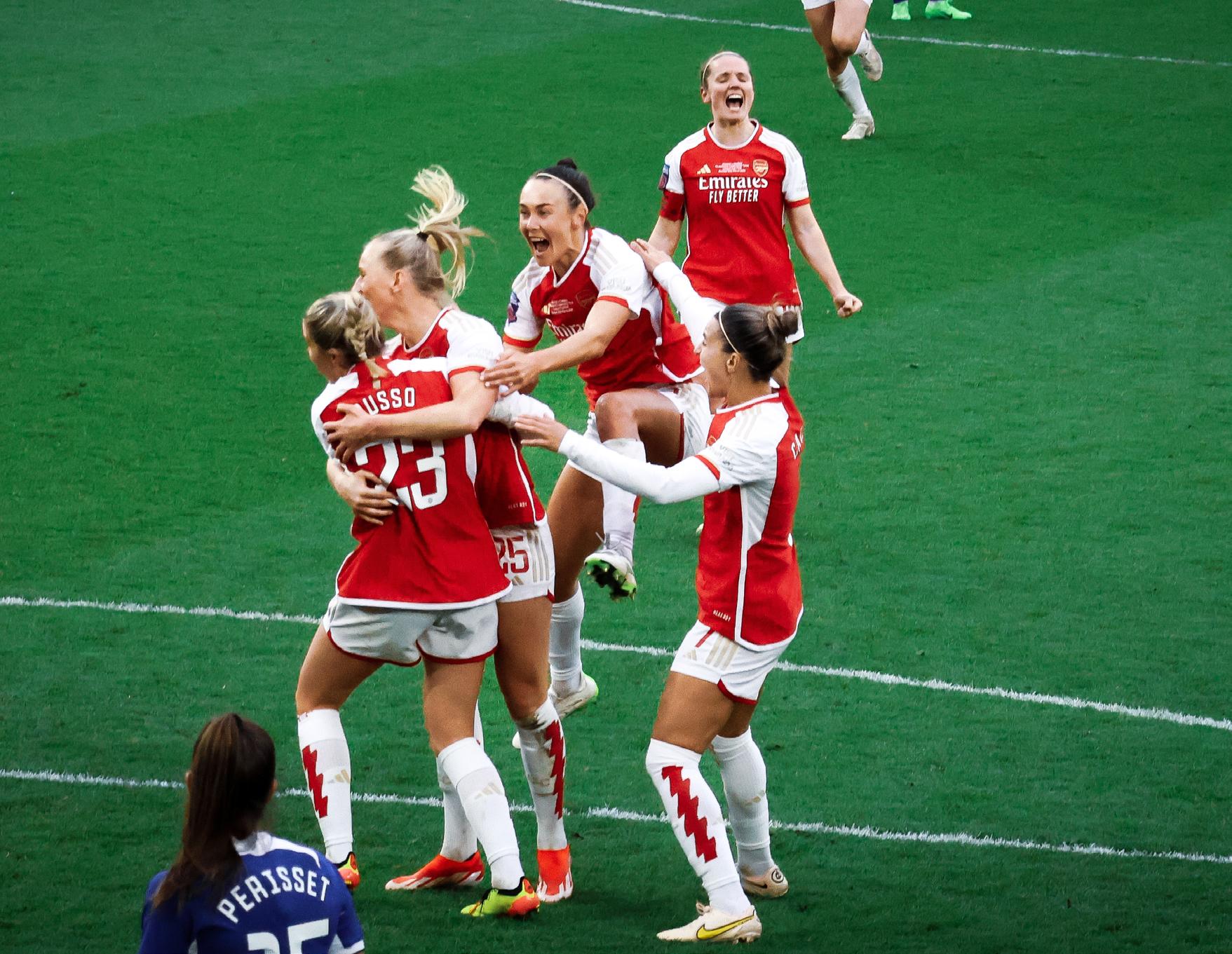




JoChurchman joined Arsenal from Millwall Lionesses in 1990 and spent five years under legendary manager (and Arsenal men kit man) and pioneer of women’s football Vic Akers. The former Arsenal striker spoke exclusively to the Gooner about her memories of playing under Vic, running laps around Highbury and wearing Alan Smith’s kit.
Vic Akers picked me to sign for Arsenal from Millwall Lionesses when they were in the Greater London League. Because Vic was the league representative manager, he would pick a team from the league to go and play in representative games. I just thought it was a better setup and everything.
I always got on with Vic. He could have his moments, like anyone, but I always got on well with him.
Vic was always, and still is, very quiet in his demeanour and everything. But he would get teams to play. Vic was always very calm, until you got in the changing room.
In the 1995 FA Cup final, we were losing 2-1 to Liverpool, and it was Sky Sports covering it, and they wanted to come in the changing room while Vic was doing his half time talk.
They were actually formerly Aylesbury

Ladies, a lot of the ladies from Aylesbury came because a couple of the girls from there worked at Arsenal

He wouldn’t let them in, he slammed the door in their face. It was on live TV, so he didn’t want them. We weren’t doing brilliantly, but we went on to win it.
His life was Arsenal Football Club. He would spend his days at Highbury or Colney Heath, doing the kits and everything. Because the kit man doesn’t only just do games- he’s around at the training sessions as well.
We trained at Highbury on Tuesday and Thursday evenings, because they used to have an indoor astroturf at the back of one of the stands, where the underground car park was.
We used to do our physical training in the stands at Highbury and around the pitch. When Vic came out with the batons you knew you were doing horseshoes.
That’s where one team starts at one goal with a baton, one team starts at the other with a baton. And you had to race each other around three quarters of the pitch and hand the baton over to the next person, and you kept going until he said stop!

“I used to play for the Arsenal Ladies team. Funny enough, I used to have your hand-me-down kit!”

When I was there they set up a YTS (Youth Training Scheme). I’m sure it’s pretty much probably a younger version of what they have now, where the girls go down to Oaklands College. They used to have young players do a college course, and they’d work at the club as well, doing jobs in the club shop for example. And then other players that were not necessarily part of the YTS scheme, they would have jobs around the club, like in the sports centre that was attached to the ground, or the ticket office.
I was there in the very early days. Arsenal Ladies were formed in 1987 by Vic as a competitive team. They were actually formerly Aylesbury Ladies, a lot of the ladies from
Aylesbury came because a couple of the girls from there worked at Arsenal.
Vic was very on the ball of what was sustainable, and what wasn’t. When we first started, we used to play all of our home games at Leighton Wingate. And the thing you might find is still some people that used to go and watch us there go and watch the girls now, so they built up this core of fans that came along and watched.
But it was just about being sustainable, really. None of us could be paid because there was no money to pay us. But our recognition changed once we got the success of winning the cup. In 1993 we won the League Cup, the FA Cup,


and the League. The Women’s League Cup final was played at Wembley.
It was the first ever year of the [men’s] playoffs, and it was the Third Division play-off final between York and Crewe.
Wembley allowed us to play our cup final against Knowsley, which became Liverpool, and Vic was the one who organised that. He said ‘let the girls showcase at Wembley.’
There was hardly anyone there, it was a few of our families and stuff like that, because Wembley insisted on still making them pay £12 pound a ticket, which was a lot of money then.
So, he said “Let’s have this fight. Why don’t you have this final at Wembley? It’s a perfect opportunity to showcase it.” And they did, but we weren’t allowed in the main changing rooms, so we were stuck somewhere else.
The men’s team were playing in something that day, or the reserve team, and they were keeping an eye on the score, seeing how we’re getting on.
So it was just about becoming recognised and it becoming sustainable.
Vic was the main drive for getting women’s football recognised, especially for us in terms of what he expected- our behaviour and how we represented the club.
How you behaved when you were out, even if you went on socials, how you presented yourself, because what you do, that’s what people see.
There was a big drive in that sort of thing, like the way you dressed when you went to games. But he was really good.
He got us our first sponsorship with the Daily Star, and he got our first sponsorship with Puma, Puma boots. We all got free boots. It was like Christmas!
I bumped into Alan Smith recently, who is a member of my golf club. I happened to see him
a couple of months ago in the car park. I said to him, “Oh, Alan, Vic Akers says, if I ever saw you to say hello,” and he said to me, “How do you know Vic?” I said “I used to play for the Arsenal Ladies team.
Funny enough, I used to have your hand-medown kit!” And he’s about two feet taller than me! We used to have all the men’s hand-medown training kit. We were all provided with training kit, albeit twenty sizes too big! But Vic wanted us training in the same kit. He wanted us all representing the same thing.
In the 1992-93 season, when we won the treble, we had to play Doncaster Belles, and it was basically a league decider. And this is another thing where Vic’s very clever.
There was a boxer called Michael Watson, and he got brain damaged in a fight against Chris Eubank. He was a massive Arsenal fan, and they held a fundraiser for him.
They had an ex-Tottenham versus ex-Arsenal pro game and a celebrity Arsenal game. And smack bang in the middle of it, Vic puts Arsenal Women against Doncaster Belles in a title






decider! They expected 8,000 people to turn up for this day, and 18,000 turned up.
Vic was very clever. He went: “Right. There’s two games. There’s an ex-pro game, ex Tottenham and Arsenal pro game. There’s a celebrity Arsenal game, and my girls are going to play Doncaster Belles smack bang in the middle of the day.”
And everyone was there. It was the biggest crowd I ever played in front of!

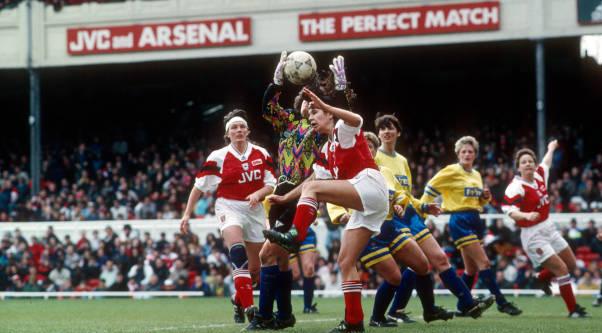




Lily Young on Arsenal’s defence and the stiff competition for places along the backline
Arsenal’s backline has proven to be a contributing factor to their success through the years, and their current defensive roster showcases a blend of seasoned professionals and promising talent.
Leah Williamson, Lotte Wubben-Moy and Laia Codina are some of the standout players who form the core of Arsenal’s backline.
Leah Williamson is the cornerstone of the defence, excelling as both a central defender and midfielder with her leadership and versatility.
Lotte Wubben-Moy adds physicality and a commanding presence in set-pieces and defensive duels, and their collaboration forms a solid backline.






Laia Codina, with her strong tactical discipline and maturity, complements both Wubben-Moy and Williamson, adapting well to different tactical needs.
The arrival of Katie Reid introduces an intriguing layer to Arsenal’s defensive strategy.
In her previous performances she showcased strong defensive instincts with her understanding of the game continuing to evolve. Reid has the potential to disrupt the current defensive partnerships and add competition for starting spots.
However, this depends on whether she stays with the senior squad for the entire season as we’ve already seen promising talents loaned out to other clubs.


Arsenal head coach Jonas Eidevall has indicated that they hope to keep Reid with the team. In a recent conversation with Gooner Fanzine, he said: “the plan is for her to be here in the squad and to get playing time, she is good enough”.
If Reid remains for the entirety of the season, the ultimate challenge for Arsenal will be balancing the established partnerships with the need to keep the defence fresh and active, and assessing how best to incorporate her into the team lineup.
While Codina’s growing understanding with both Williamson and Wubben-Moy and Williamson’s established rapport with WubbenMoy are strengths, Reid’s potential just cannot be ignored.
If she can demonstrate a responsive tactical understanding and consistency, it could prompt tactical shifts or adjustments in defensive pairings, more fluid rotations, or a potential starting spot.
It is clear that Arsenal’s defensive strength lies in its depth and versatility.

The interplay between Williamson, WubbenMoy, and Codina provides a solid foundation, but Katie Reid’s emergence really could shake up the defence.
It will be intriguing to see how Eidevall utilises Reid this season and whether she will be loaned out the second half of the campaign. Maintaining their defensive strength is central for Arsenal’s success this season- so will Reid have a role in that effort?
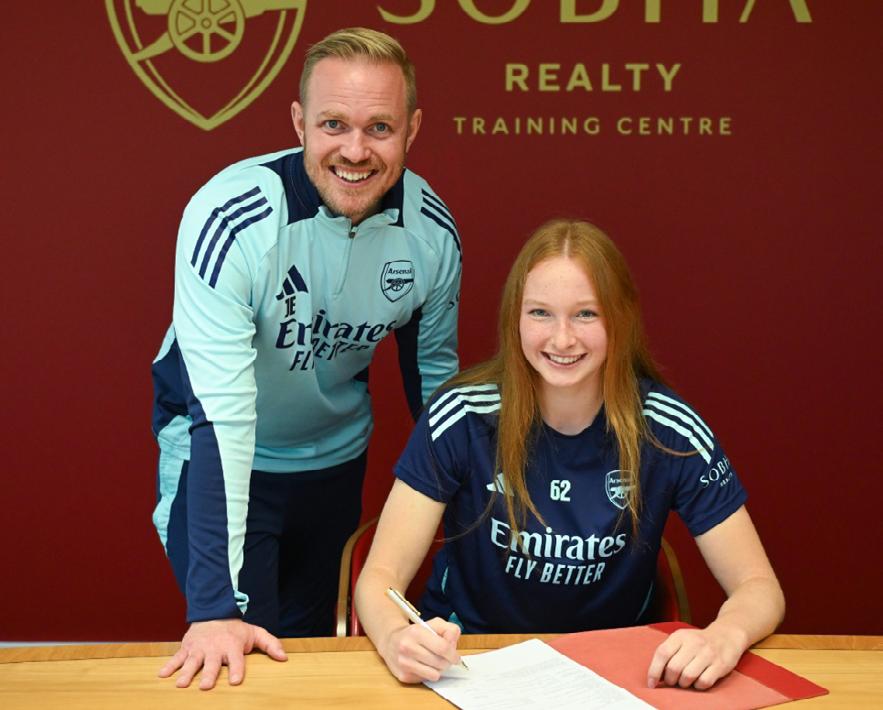






Why are airports so stressful? I’ve flown to a variety of European destinations in the last couple of years, and never really had the cause to be flustered on my travels. But there’s something in me that means I just won’t relax until I’m through security and waiting for my gate to be revealed.
So I have to thank Britain’s train network for removing my general airport stress, and directing it all towards whether I could complete the simple task of getting from across Hertfordshire to Stansted Airport, let alone Gothenburg. I got there in the end, and from thereon it was an easy journey.
We touched down in Gothenburg as the afternoon light faded, dropped off by bus
into the middle of the city, next to its famous Liseberg theme park.
I’m generally a fast walker, but there was something different about the pace of life in Gothenburg, where nobody seemed to be in a rush. I purposefully slowed myself down to ensure I enjoyed the sights and sounds, and that earlier stress was all gone.
I met up with three Arsenal fans for dinner, with the Gooner’s Lumi Lehmuskallio (featured in this very fanzine) having also travelled on my flight. All four of us went for Swedish meatballs and mashed potatoes, and they didn’t disappoint. The city is also known for its seafood, but fish never took my fancy during the course of my stay.






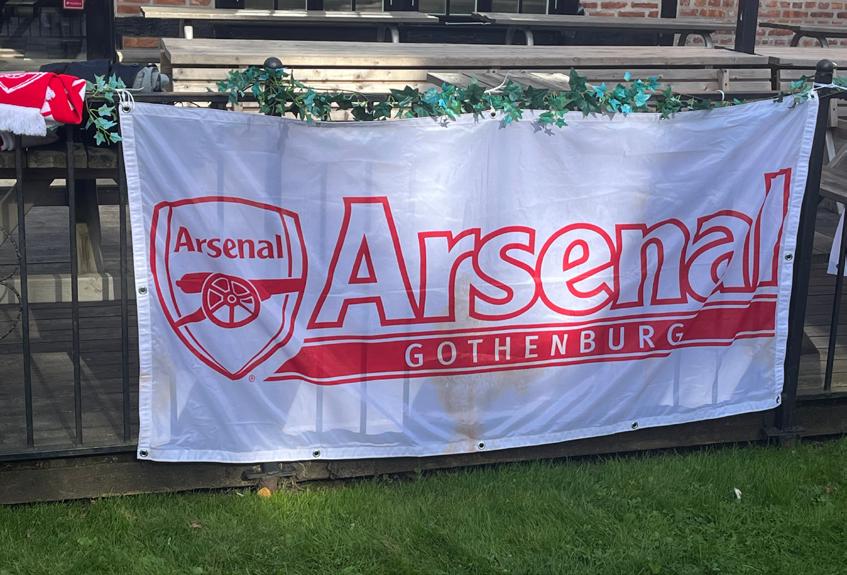


Up bright and early the next morning, I was determined to fit in as much sightseeing and work as possible before heaving north of the river in the evening for what I, and all of the Arsenal fans, were here for, the game itself!
Myself and Lumi recorded a short video podcast in a scenic river spot, the small Lejontrappan boat terminal. The perfect sunny backdrop to show off Gothenburg, with a beautiful church and Stadtmuseum behind us.
Then, a slow stroll along the Göta Älv river, which divides the city in two and forms much of the cultural heritage of Sweden’s secondlargest city.
A venture up to Arsenals-gatan (translation: Arsenal Street) was something of a rite of passage, before exploring Gothenburg’s Hagathe city’s most historic area, formed of charming cafes and cobbled streets.
Climbing up to the Skansen Kronan, once a fortress to defend the city from the threat of Danish attack, revealed picture-perfect views all over the city, at this point basking in Scandinavian sunshine.
After writing up some match previews as well as a newsletter piece for our email subscribers, I took a tram over the river for a spot of lunch before walking over to the Arsenal fans’ traditional pre-match meet-up in the Hisingen area of the city, BK Hacken turf. The Gunners’ loyal supporters meet in loyal numbers before every game, home and away, and this
particular occasion had been organised by Arsenal Gothenburg. The loyal Swedish Arsenal supporters had travelled from all over the country to cheer on Jonas Eidevall’s side, as they did when the Gunners were in Linkoping in 2023-24 qualifying.





Many had players like Freddie Ljunberg to thank for their exposure to and then love of Arsenal. Despite no more Swedes on Arsenal’s men’s team, the women boast four Swedish internationals as well as a head coach born less than an hour’s drive from Gothenburg.
Conversation really flowed easily, with fans from all over Europe united by their one true passion: Arsenal.
Slightly-confused locals turning up to the Ölstugan Tullen Kville pub for a post-work drink encountered a friendly mass of red and white, enjoying the sunshine and one or two delectable Swedish beverages.
It was a day where football was easy to forget about, such was the enjoyment of discovering Gothenburg and meeting up with the travelling Gooners, but I had a game to report on, after all.
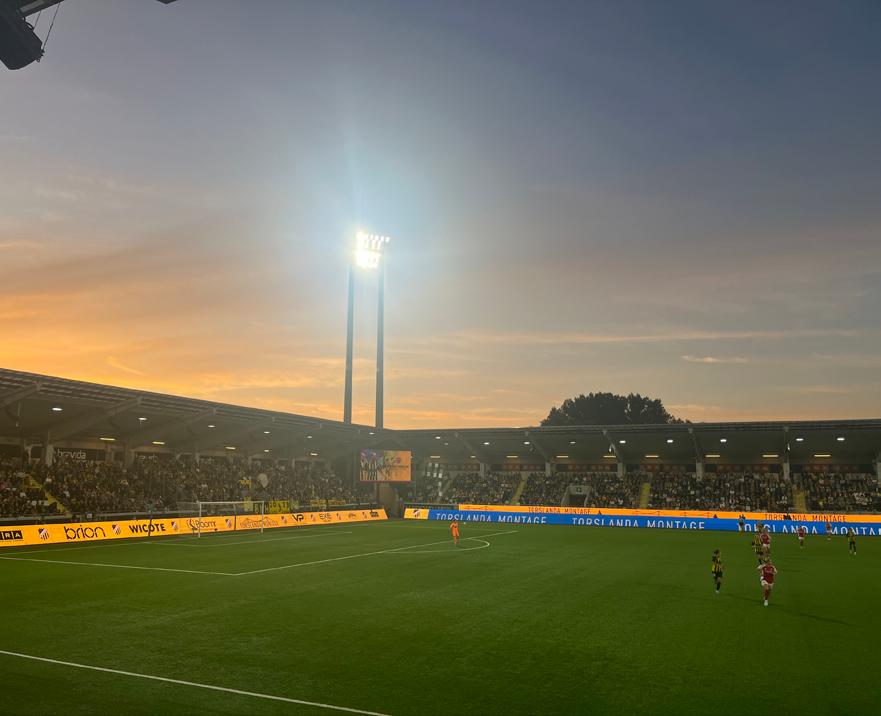




The Hisingen Arena was barely noticeable from its closest tram stop, a modern, rather compact arena with an artificial pitch. It was able to produce an atmosphere though, with both sets of fans contributing to a strong level of noise before kick-off.
I was one of only three journalists who had travelled over from England, with the Gooner’s Suzy Lycett one of a couple of photographers to have made the journey.
It was a proud moment for both of us to be plying our trade overseas, and despite a 1-0 defeat for Arsenal on the night, it was a game I will always remember fondly because of the trip, the company and the city.
After Arsenal’s dominant second leg comeback, there will be a few more European adventures to come this season. Thank you very much, Gothenburg.











Leadership is at the heart of success in football, and in North London, it’s more than just a trait- it’s a tradition.
With iconic captains like Kelly Smith and Alex Scott in the club’s history, leadership at Arsenal runs deep.
The current squad carry this legacy forward, blending seasoned veterans with emerging talents, proving that leadership is about much more than tactics- it’s about inspiring those around you.
In football, leadership isn’t just about who wears the captain’s armband, it’s about understanding the needs of the team, setting the tone for collaboration, and being there when things get tough. Arsenal captain Kim Little and vice-captain Leah Williamson showcase this perfectly.
Little’s calm, thoughtful approach is a hallmark of her leadership.
But leadership also evolves. Williamson, seen by many as the next in line to take the mantle, represents a new generation


Having played across four leagues, the former Scotland international brings a wealth of experience back to Arsenal. Now in her 10th season as a Gunner, her steady influence has guided the team through many fi challenges.
Little has served as a transformational leader, guiding younger players like Vivienne Lia and Katie Reid to grow not only as footballers but also as future leaders themselves.
But leadership also evolves. Williamson, seen by many as the next in line to take the mantle, represents a new generation.
Her leadership comes from authenticity, helped by being a childhood Gooner, making her first team debut ten years ago in 2014, and captaining the Lionesses to groundbreaking European glory in 2022.
She leads with empathy, resilience, and a strong sense of responsibility both on and off the field.
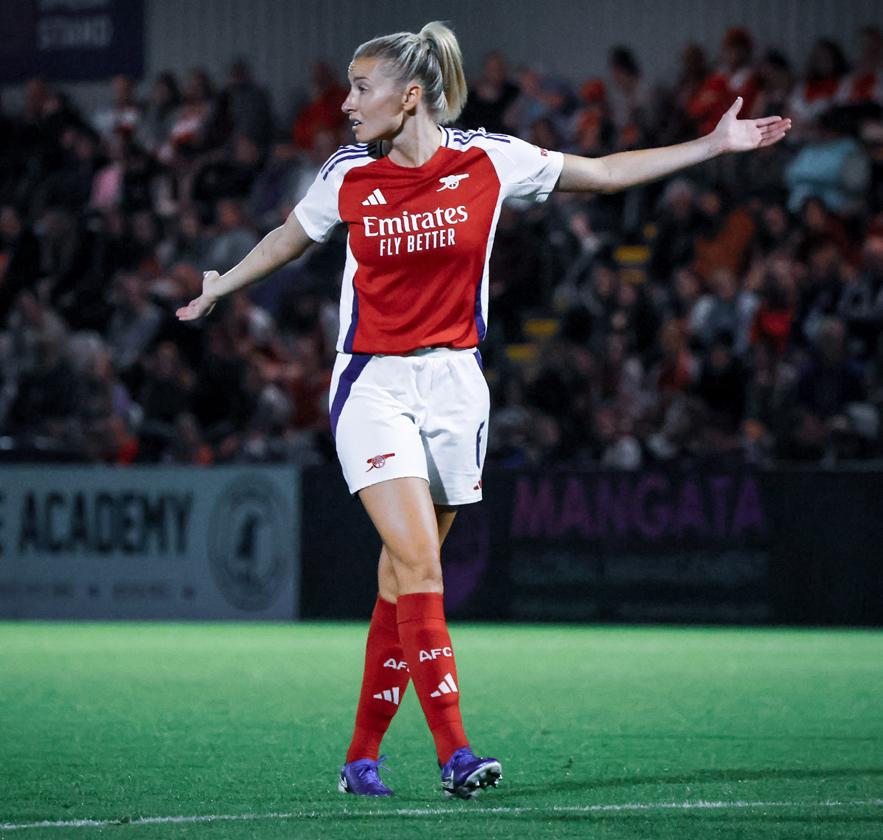





Her defensive prowess and control on the field make her a key figure in Arsenal’s future, excelling at recognising cues in the opposition’s play, engaging at the right moments, and transitioning the team effectively from defence to attack.
Football doesn’t always need vocal leaders shouting instructions from the back. Sometimes, the best leaders let their performances do all the talking.
John Wooden, a legendary basketball coach, famously said, “The most powerful leadership tool you have is your own personal example.”
Alessia Russo is one such example, in her first season with the club, her sharp instincts in front of goal- scoring 12 times in what was an underwhelming campaign for her side- showed she is more than just a forward.
Her standout performance in a crucial home match against Chelsea, where she scored twice, was the kind of leadership moment that doesn’t require words, only action, exemplifying leading by example.




The England striker followed up her star season by netting in the first competitive game of the 2024-25 season against Rangers in the first qualifying round of the Champions League.
Arsenal’s commitment to leadership goes beyond individual players, however.
It’s about cultivating a culture where everyone is encouraged to step up, whether that’s through guidance from experienced players or support from the coaching staff.
Former manager Joe Montemurro played a crucial role in fostering this kind of inclusive environment, and the effects can still be seen and felt today.
Looking back, the club’s Champions League triumph in 2006-07 set the standard.
Legends like Kelly Smith, Lianne Sanderson, and Alex Scott didn’t just win on the pitch- they set the tone for future leaders.

Their influence still echoes through the current squad, with Smith now coaching the first team and Sanderson and Scott putting their expertise into punditry.
As the red of North London looks toward the future, the club is preparing the next generation of leaders.
Leah Williamson’s rise, coupled with the steady presence of Kim Little, provides a powerful combination of leadership styles.
With Williamson, there’s a sense of humility and genuine care for her teammates- qualities that are increasingly as important as any defensive skill she brings.
The blend of this with the youthful energy of rising stars, the team is not just building for immediate success - they’re crafting a culture where leadership is passed down. The club’s legacy of excellence will continue for years to come, as seen for the past 37 years.





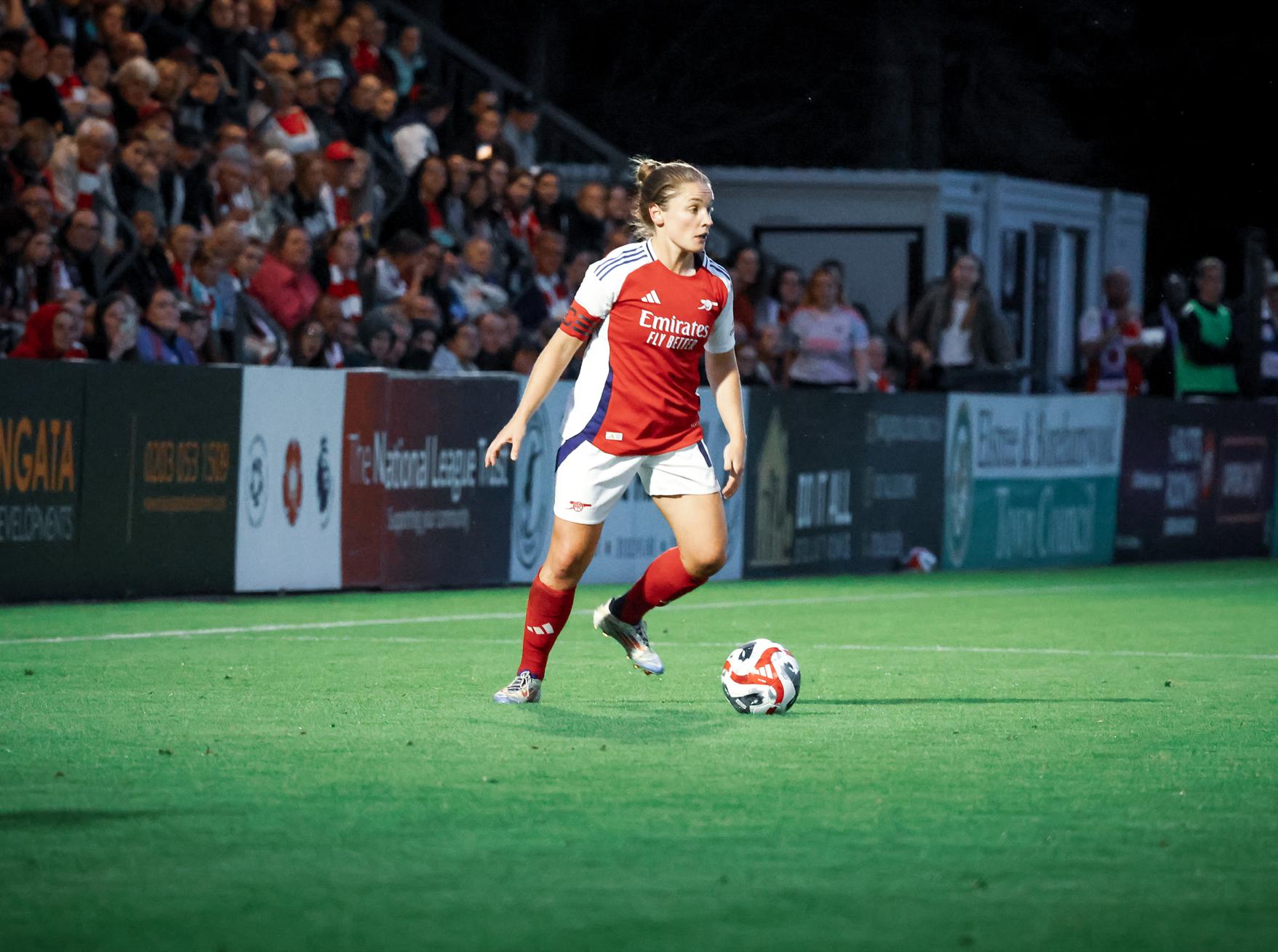







@Nancy_Gillen
The walk across the North Bank Bridge or under the Hornsey Road tunnel has been a pilgrimage for many Arsenal fans since 2006, when the club made the short journey from Highbury’s marble halls to the 60,000-capacity Emirates Stadium.
The air becomes thick with songs and chants as fans push through the turnstiles and onto the concourse, ready to support their team for the next 90 minutes.
This experience will now become a regular occurrence for supporters of the women’s team, who will be playing the vast majority of this season’s matches at the Emirates.
The side have been based at Meadow Park in Borehamwood since the early 1990s, even winning their historic Women’s Champions League title at the ground in 2007.
They occasionally played at the Emirates, but it was a rare occurrence.
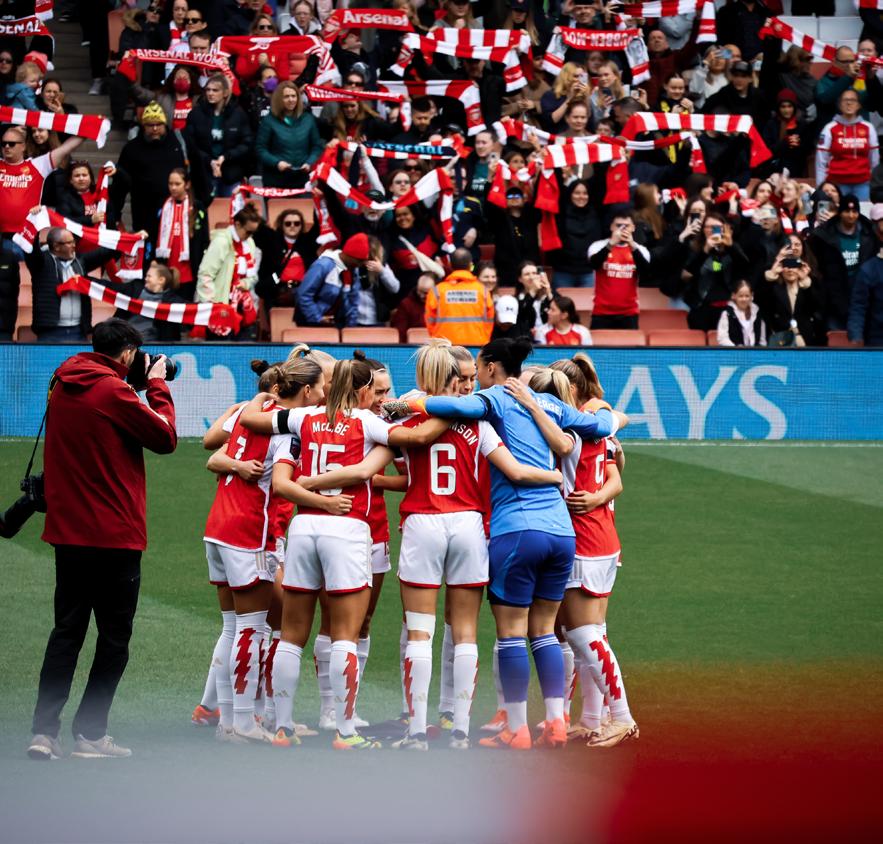



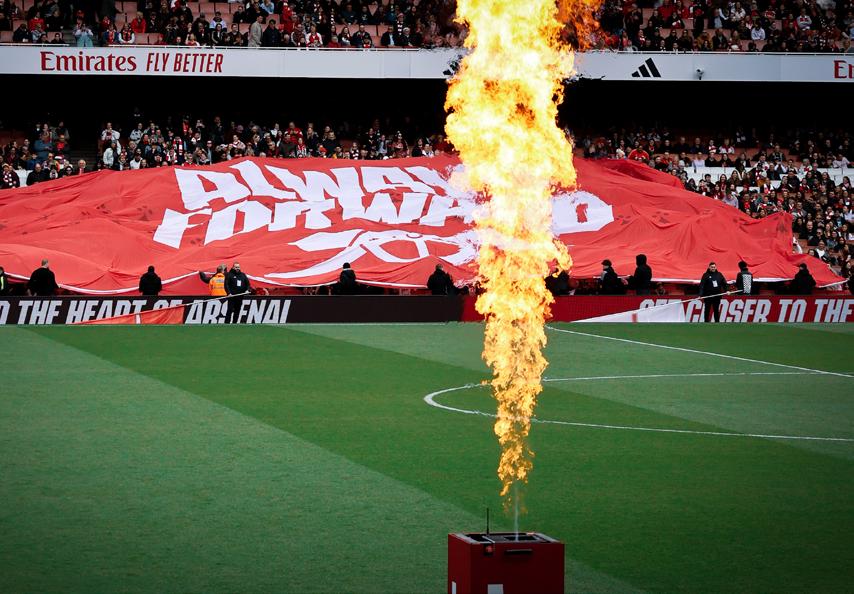
There was a concerted effort to change this in 2021. Arsenal combined an increased number of women’s matches at the Emirates with an effective marketing campaign, and slowly but surely the attendances grew.
Before too long, supporters started to pour into the Emirates in their thousands and Women’s Super League attendance records began to crumble.
Within just a couple of years, the once unimaginable happened - tickets sold out for Arsenal’s semi-final encounter against Wolfsburg in the 2022/23 Champions League. On the day, the 60,063 fans in the Emirates experienced a rollercoaster of emotions and
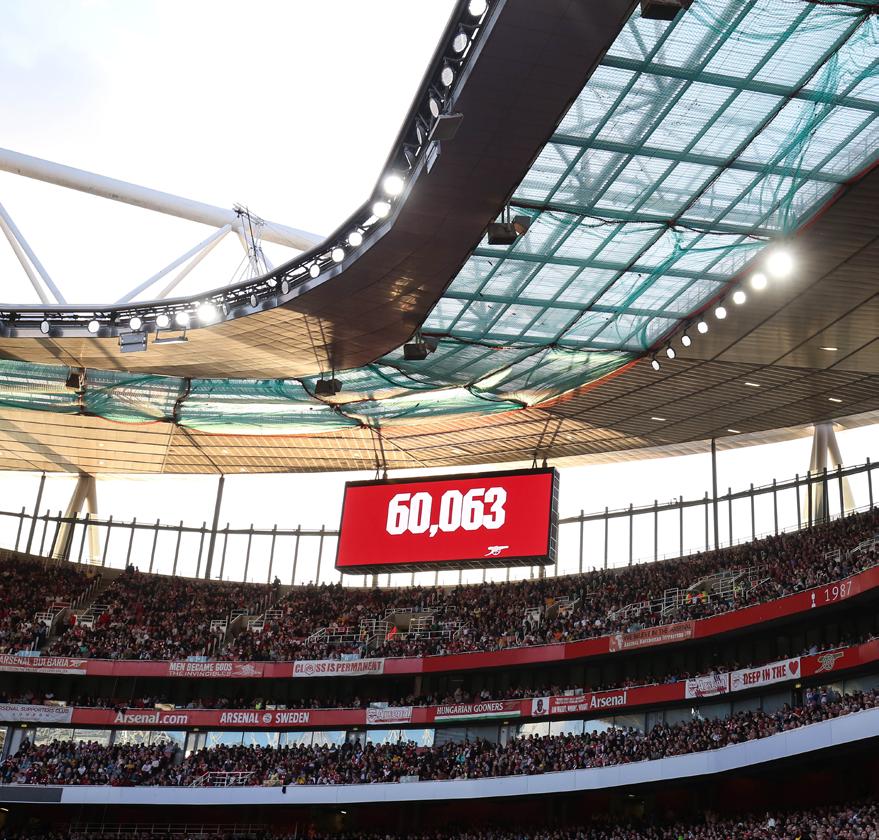

were ultimately left heartbroken after a dramatic 3-2 loss, but history had been made regardless.
Last season, the Emirates hosted back-toback sell-outs in the WSL. These matches – a 3-1 victory against Manchester United and a 1-0 triumph in the North London Derby – were more joyous occasions.
As the attendances grew exponentially, so did the atmosphere.
The majority of the players now have bespoke chants which are sung loudly throughout every game, the rendition of Louis Dunford’s “North London Forever” before kickoff induces goosebumps.
The designated ‘Bring The Noise’ section in the Emirates from this season should only serve to encourage even more fans to take part.
Indeed, Arsenal truly have the opportunity to enhance their status as a trailblazer in women’s football this season.
The club had the highest average attendance in the WSL last season with 29,900, considerably more than the second highest, which was Manchester United with 10,957. But last season’s average could really be blown out
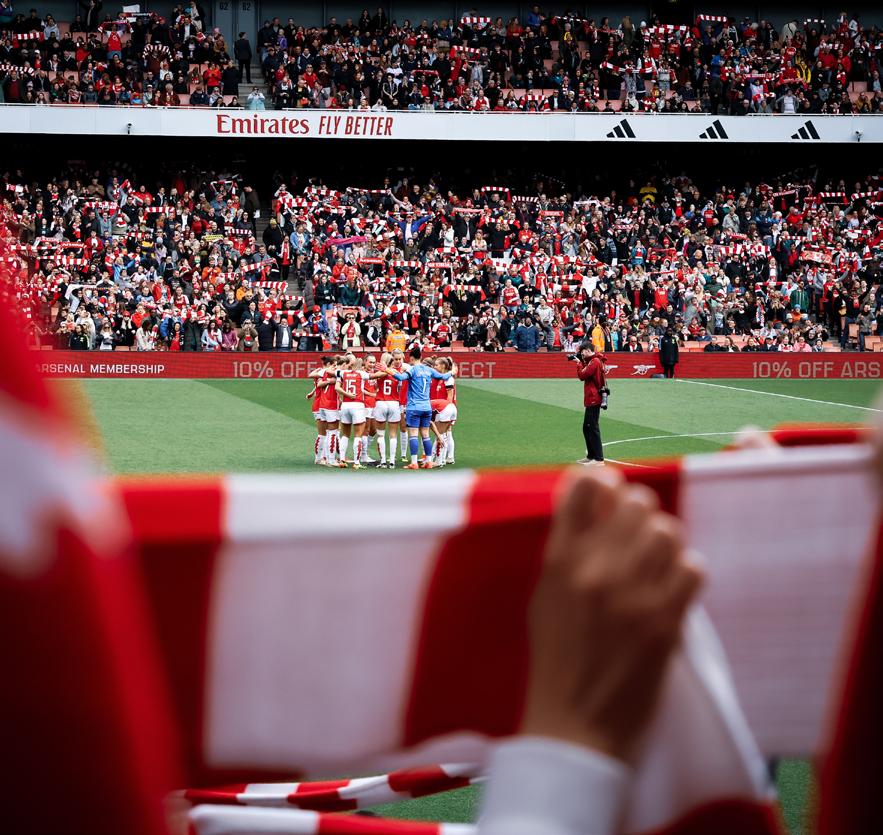

Arsenal truly have the opportunity to enhance their status as a trailblazer in women’s football this season
of the water during the upcoming campaign if fans continue to pack out the Emirates.
This not only gives a boost to the team on the pitch, but it shows that women’s football is commercially viable, attracting more sponsors and investment.
It also gives supporters the chance to build a unique culture and atmosphere that sets the standard in the women’s game, encouraging other fans to follow suit.
All of this hugely contributes to the fast growth of women’s football, and in years to come, these moments will be looked back on and seen as crucial in the rise in popularity of the women’s game.
It is incredible to see Arsenal at the forefront of this and it will be an honour to be a part of it at the Emirates this season.
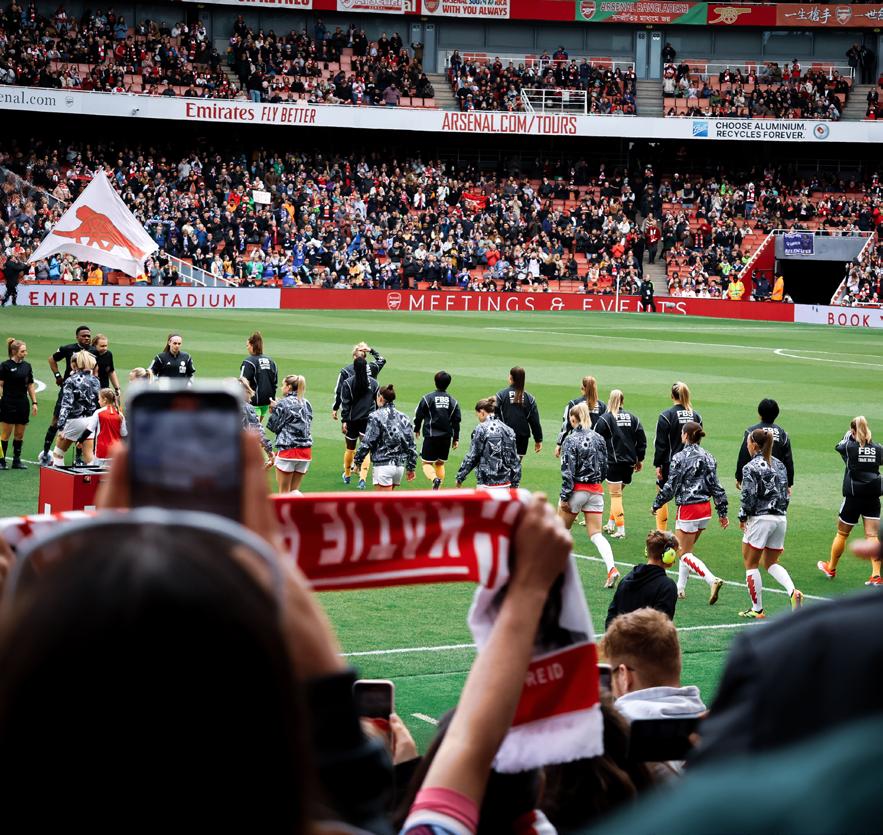




Liberty Simons explores the links built up between Arsenal and Swedish clubs recently
There is a clear Arsenal and Sweden partnership that has built over the past few seasons.
From the appointment of Jonas Eidevall in 2021, there has been a trajectory between the English club and Scandinavian country.
While signings like Stina Blackstenius and Lina Hurtig emphasise Eidevall’s trust in his compatriots, it’s signings straight out of the Swedish top flight, the Damallsvenskan, that draw the most attention and excitement.
Over the past two seasons, Arsenal have spent an estimated combined amount of over €550K on two of the Damallsvenskan’s brightest stars.



Liberty Simons @libertysimons
Between Hammarby IF’s Kyra Cooney-Cross and BK Häcken’s Rosa Kafaji, Arsenal showed a trust in the next generation growing in Sweden.
They were the profile of player that the Gunners needed, and the confidence to buy youthfully increases squad depth for the future.
It’s not a new phenomenon that clubs go shopping in the topflight of Swedish football.
Chelsea and Wolfsburg were amongst the first big names to go shopping in the league. And before European sides got involved, Marta was swapping between Sweden and the USA over a number of years and clubs to help her grow into the best player the game has seen.
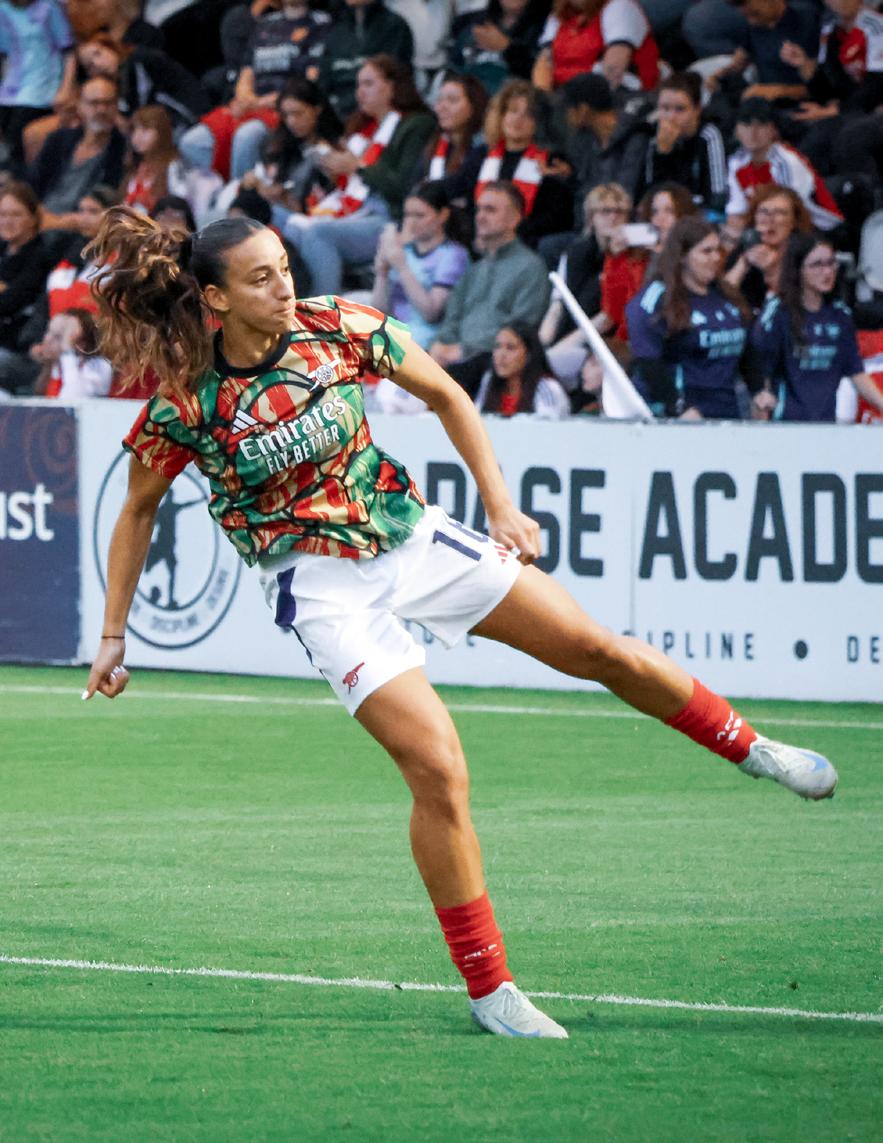

However, Arsenal’s big price tags over two summer windows feel different. Both CooneyCross and Kafaji were 21 years old at the time of their signings, and nearing the end of their contracts within the next few months.
With these players coming after excelling in different international tournaments, Arsenal’s confidence in buying players instead of waiting to get players on free transfers at the end of their contracts stands out.
With Arsenal putting the price on young players and delivering to smaller clubs in Sweden, the game grows all around. Money and investment pushes the game forward and means everyone truly benefits.
Cooney-Cross and Kafaji excelled in the Damallsvenskan. Both technical and expressive midfielders, they are a part of Arsenal’s here and now, as well as the future.
Across two transfer windows in a row, Arsenal have welcomed some of the most exciting young players in the Damallsvenskan. One Australian and one Swedish but both wowed and excelled in Sweden.


With Arsenal putting the price on young players and delivering to smaller clubs in Sweden, the game grows all around
For two seasons, Arsenal have not been afraid to splash the cash for the investment in the future, as well as cementing the present.
With Arsenal once again setting the precedent in women’s football as well as other WSL clubs showing Damallsvenskan interest, it’s only a matter of time before the cash starts flowing from more clubs too.
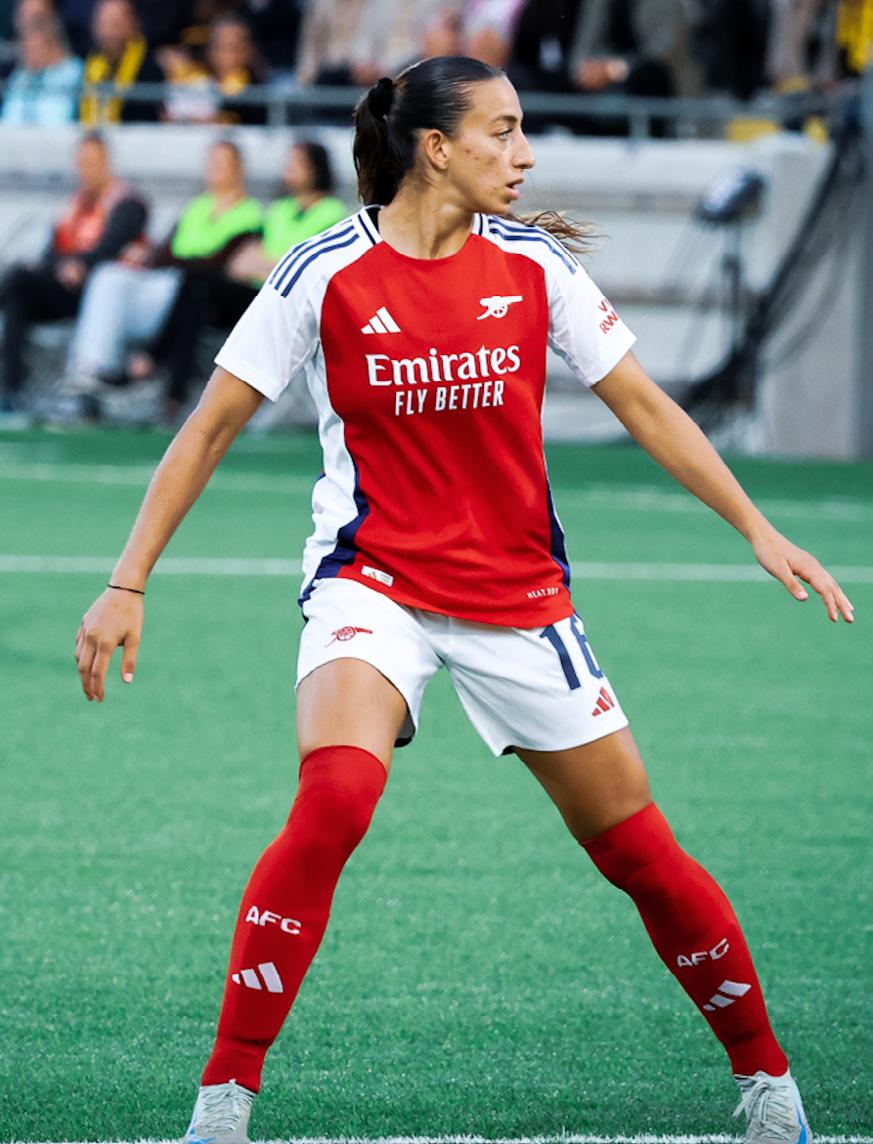



Mum and daughter Niamh and Ellie are well known for their loyal support for Arsenal, and their compatriot Katie McCabe.
How did you become supporters of Arsenal Women?
We went to our first game with Ellie’s football team. It was Arsenal against Liverpool in November 2019.
We had always supported the men’s team, with Ellie going to games at the Emirates with her dad since she was four.
After the first game we both went regularly to games as and when we could, straight to matches after Ellie’s training or games.
Ellie was at the Emirates after the Lionesses won the Euros. Lotte Wubben-Moy approached her and put her Euros medal on her and Ellie just fell in love with her and the team even more. Lotte could have picked anyone but she picked her. It was very special.

Each issue we put the spotlight on a Gooner subscriber and loyal Arsenal supporter. You can be featured here too, just get in contact with us.
Katie McCabe. The Irish connection is strong and I love how proud she is of our little country. She is such a good representation for Arsenal and Ireland and she has been nothing but kind to Ellie since the first time she met her. Ellie wants to be just like her. She is working on her physicality and started playing Gaelic football to build on that. I hope she avoids the yellow card trend! Katie came looking for her after a Chelsea away game and gave her the match worn top. She recognised Ellie and her flag from all the games she’d been to previously.

I don’t think we have missed a home game since that day.
I joined the Supporters Club in 2022 and this will be my third season on the committee.
Best game and why?
Beating Chelsea at the Emirates last season. The atmosphere was absolutely amazing and at this stage we had made so many new friends. Ellie said it was the best day ever!

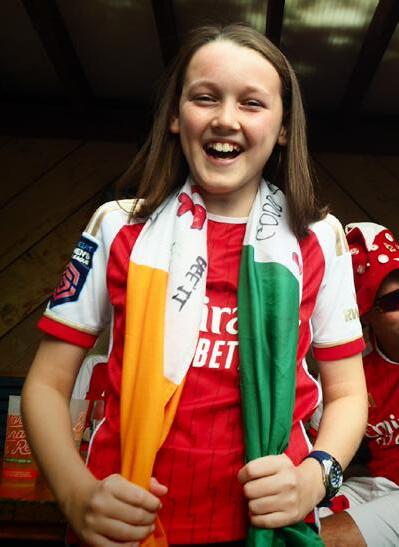
What does Arsenal Women mean to you?
Our lives revolve around Arsenal. We don’t miss a game- we work around the fixtures.
Ellie plays football and we are so glad that the women’s games are on Sundays so they don’t clash with her games. We love our team, our friends and our football life.
We can see us winning the league this season but I think it will be tight. This is our season- they will do it for the fans. We both feel very very excited about this and feel confident. Loving the link ups between Fox and Foord and think Caldentey is such a good signing. We have the squad. We just need the results.

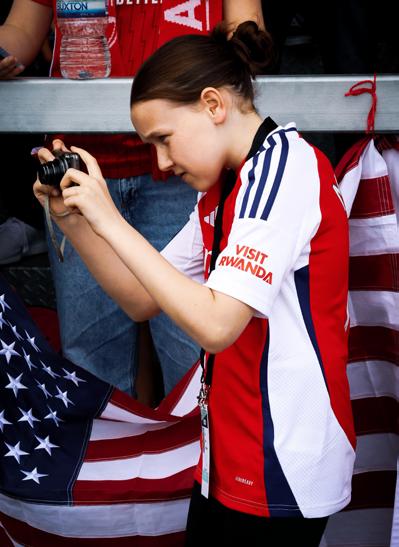


Women have gone from a home ground of 4,000 to a stadium of 60,000. That’s more than fifty-six thousand new supporters, and demand continues to grow, bringing with it new characteristics, personalities, and opinions.
Gone are the known demographics of those ticket holders.
In the men’s game, traditions have been passed down. Rivalries are entrenched and are rarely questioned; a club is a club for life.
Those supporters still attend, and yet the women’s fanbase throws up other unpredictable variations.
It’s no longer simply ‘family friendly’, for one. True, young boys and girls have new role

models they can identify with and aspire to be. But, beyond that, the fanbase is evolving.
We all support the team and consume football differently.
Traditional and long-term fans of Arsenal’s men’s and women’s teams bring a pre-existing passion, knowledge about the ins and outs of football, and an understanding of the club’s history and values.
They also bring preconceived notions of what football is and has to be.
And that sense of hierarchy will change, as the fanbase morphs into something new.
New fans bring big crowds and enthusiasm that leads to passion.
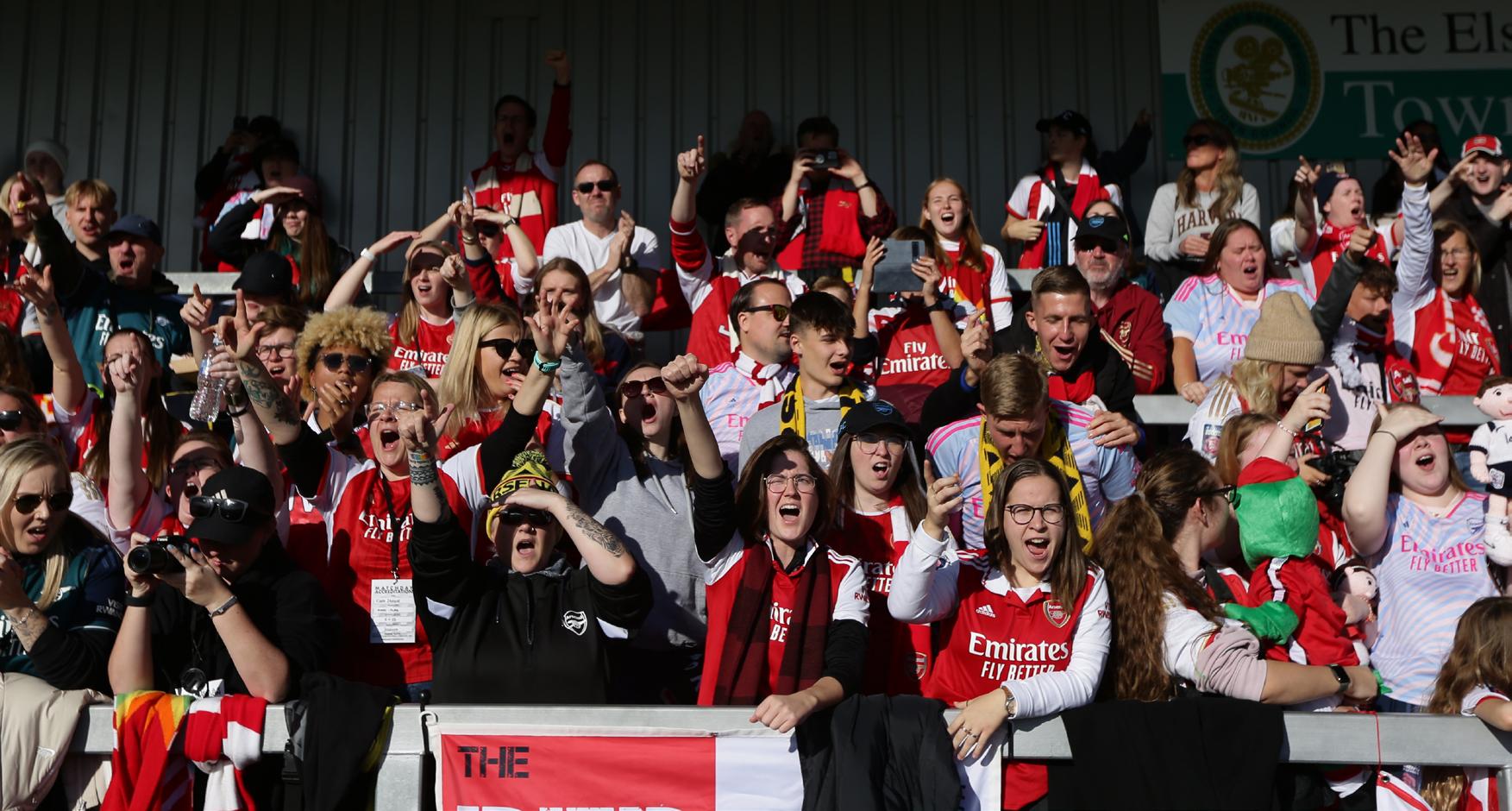
They may not necessarily ‘know ball’ when they start to follow the game but everyone has to start somewhere.
Some will be on the hype train. It’s cool to support Arsenal at the moment. People want to be part of the crowd.
Others may be here for individual players only, with little club loyalty.
An online poll from She’s A Baller showed that 58% of respondents said they intend to follow Viv Miedema to her new club.
We may gain and shed those fans as players come and go.
However, many new fans will fall in love with Arsenal - and many have already.
I, along with many others, discovered in Arsenal’s stands a place where I could be free from everyday worries for 90 minutes a week.
Among like-minded people, I could simply support my team.

I suspect it’s something that many fans will have in common.
It’s a cornerstone of our support: inclusivity and creating a welcoming atmosphere. That’s been an enduring characteristic of our fanbase, something everyone wants and strives for. However we entered the game, we should not lose sight of that.
Arsenal encourages that inclusivity - which will lead to loyalty.
The club shares insights into the player’s lives and Arsenal’s ethos and values to help those near and far build connections with the club. On the pitch, they aim to give us something to cheer for, week in, week out.
Club loyalty takes time to build and those fresh foundations are being laid.
Some of the new fans will stay, some will move on. Those that stay, new and old, pass their passion to others, and that’s how the demographic for women’s football - and Arsenal - will be defined.







Abusive and discriminatory behaviour are completely unacceptable no matter how many or few instances there are says Richard Smith from AISA
Did you see the latest Arsenal Against Discrimination video at the Arsenal men’s match against Wolves?
Did you see the latest Arsenal Against Discrimination video at the Arsenal men’s match against Wolves? Do you ever wonder why we are watching yet another warning against hate crimes when you’ve never seen one yourself on a matchday? Have you ever wondered why they keep on about it?
The club says there were only twenty-one confirmed cases of supporters using abusive and discriminatory behaviour during the 202324 season. Out of 60,000 multiplied by the number of matches played at the Emirates, that’s tiny, surely? And as most of us haven’t seen it or experienced it, let alone done it, why raise it?




Richard Smith @AISA_Arsenal

Why 21 cases of abusive and discriminatory behaviour at Arsenal is 21 too many
The issue is that it’s happening at all.
That it’s completely unacceptable no matter how many or few instances there are. It’s also an issue that if it is seen, it’s invariably passed over as banter or that the problem will go away without need for intervention. Except for the person on the receiving end, it does not go away; it remains and damages, if not physically, then mentally.
Yet if we’ve not seen it, what are we looking for? What does abuse and discrimination look like? Websites describe it as sexual assault, tragedy chanting, offensive gestures, racism, homophobia. . . . and shockingly, all of these have been reported at the Emirates.
So what can we do to stop it?
Police outside the stadium have body cams to record any abuse they see, as do increasing numbers of club stewards inside the ground. Their video evidence can be used when


bringing action against abusers. And what is the sanction for those who are caught? The police can bring charges against individuals. But the club can – and does – take its own steps - by revoking supporters season tickets and access to the stadium.
Of the supporters found guilty last season, each has been handed bans of at least one year, with fourteen handed three-year bans, meaning they cannot attend any Arsenal match home or away during that period.
But however many police, stewards and cameras there are, there are more potential witnesses who can report abuse. Us. The supporters. If we see something that doesn’t look right, we should be reporting it.
It may not be happening in front of us all the time, but we should be mindful and aware – and if we see it, as the club says in its publicity – tell someone or text ‘FOUL’ to 67777 (and taking screenshots if possible).
Although it can also be reported online after, reporting it there and then, while it’s happening, is by far the most effective approach. The end game isn’t necessarily to see people fined or banged up. The risk of losing season tickets and access to the stadium might be enough to deter most abusers.
But all punishments are just last resorts. The real prize would be for abuse and discrimination not to be happening at all. In truth, it shouldn’t be happening anywhere, but travelling to and from a match or while inside the stadium, we’re all together as Arsenal supporters, representing the club as much as the players, whatever gender, sexual orientation, race, religion or belief, and we should be supporting each other.
We should not be abusing one another. We’re better than that. We are Arsenal.
The website for reporting online can be found at https://www.arsenal.com/news/reportabuse-and-discrimination. We all know about online abuse, but the scale of it affecting Arsenal is mind-blowingly horrific.
In the last twelve months, there have been over three million messages, posts or comments mentioning an Arsenal player’s handle or the club generally.
The club is working with a data science company, Signify, to use AI to scan across all social media. It looks for key words related to abuse and hate directed at players, coaches, officials, even the ticket office and various supporters’ groups.
Of those three million, around 115,000 were read individually by members of the Signify team. From these, 4,500 were verified as abusive and reported through to the platforms. But, as seems to be the case more widely, not all were taken down.
However, Signify, does not let it end here. They focus on the most concerning accounts sending those messages, and provide the club with evidence on any that are affiliated to the club – for instance, season ticket holders.
Where links are found - and cross a criminal threshold - they recommend that the club share any relevant info with law enforcement. The club also uses that information to take action of its own when it can, by removing said abuser’s season ticket.
Last season, three supporters received bans. Three may seem a small number, but the deterrent effect has seen a 90 per cent decrease in online abuse detected amongst Arsenal members.
Of course, the problem persists across all social media, and it’s getting worse. But for the Arsenal, it’s showing as a 24 per cent increase in online abuse to what the club calls its ’player and coaching family’.
There’s little we, as supporters, can do to prevent this abuse – aside from not sending any, of course.
But it is clear the club is taking every step it can, so that its employees on and off the pitch can carry out their work without suffering abuse.




Arsenal Women’s growing fanbase owes much to social media’s power to engage and connect. Lumi Lehmuskallio explores how
I’mLumi Lehmuskallio, a season ticket holder and a massive fan of Arsenal Women. I recently wrote a Dissertation for my Masters Studies about “How Arsenal Women gather big audiences to watch their matches with the help of social media” by interviewing fellow fans from England and abroad. I discovered some significant findings and will tell you more about them.
The rapid growth of women’s football, especially in England, following the UEFA Women’s Euro 2022 spotlighted the importance of fan engagement and social media.
Many fans say that social media doesn’t influence their match attendance, but still, most fans attended their first-ever match encouraged by something they saw on social media.
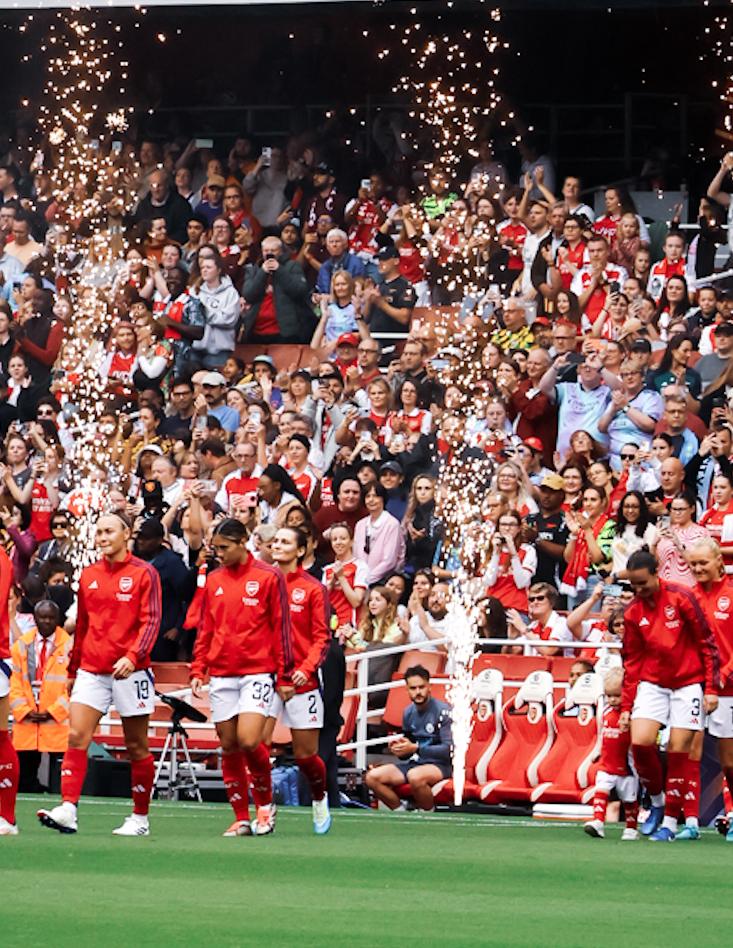





Lumi Lehmuskallio @lumimeriel
Even if the fans didn’t attend their first game because of social media, it keeps fans connected to each other, the club, and the team. We are eager to know the latest news and happenings, and by getting to know the players better, attending the matches becomes more enjoyable.
Whether scrolling through TikTok for an entertaining Lacasse and Pelova flute video or a matchday vlog, enjoying a new signing announcement about Rosa Kafaji on Instagram, or enjoying daily updates on Snapchat from Katie McCabe and Caitlin Foord, social media is where the magic begins.
AWFC’s marketing team knows this well, and with the help of the players, who now agree to help the marketing team when signing
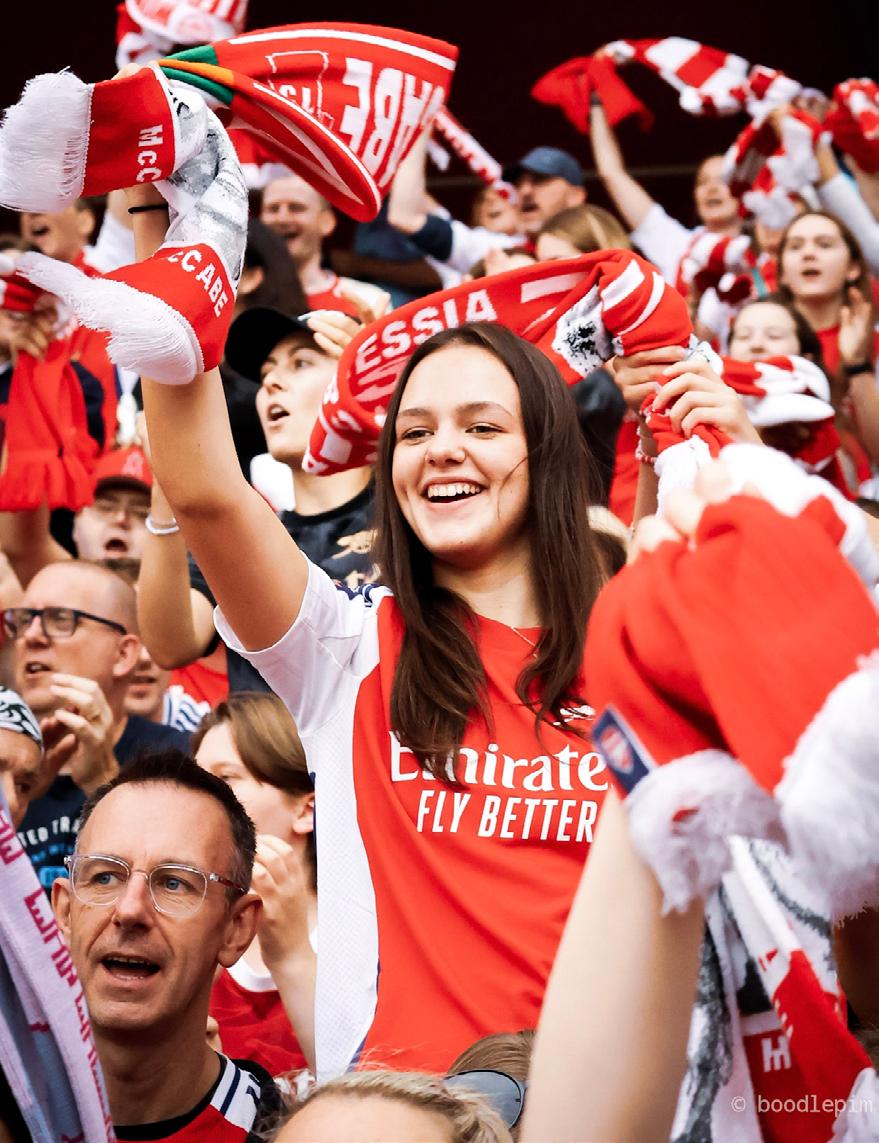

contracts, they have turned these platforms into a playground for fans.
Let’s be honest, we’re all a little guilty of FOMO (Fear of missing out) when Arsenal are playing, and we’re not at the stadium to watch it in person.
AWFC’s social media team is brilliant at playing into this. By sharing the electric atmosphere of a matchday, their posts make you feel like you’re missing out on something special if you’re not there.
What my interviews brought up is that when you’ve been a fan for a longer time, it’s usually not even the club, but seeing your fellow fans post pictures and videos of the matches you couldn’t go to that makes the FOMO hit even harder than when AWFC post something.
Also, many of us are on our phones during match days, right? Not constantly, but we check who’s in the starting 11 one hour before the game kicks off, and during the game, we might look for a video on X about why Katie McCabe got a yellow card!
If these don’t resonate with you, you surely have your phone out to at least take pictures and videos, which most of us post on Instagram Stories to show other fans and friends that we’ve been there and attended a match.
As my study shows, AWFC might have a less extensive social media following than some of their rivals like Chelsea and Manchester United, but Arsenal know how to engage with fans.
The marketing team has cracked the codesize doesn’t matter as much as the connection.
Also, it’s much more effective strategy to have a social media account for both the women’s and men’s teams than having a shared one, as the separate accounts tend to have a far better engagement.
By focusing on meaningful interactions, AWFC have filled the stands with some of the most passionate supporters in the game. Not just that, but AWFC also use their platforms to
foster a sense of inclusivity and community. Their posts aren’t just about the players- they’re about us, the fans.
Whether it’s Lotte Wubben-Moy spending time with the community and returning to her primary school or a heartfelt message from Alessia Russo thanking the fans, every post feels personal.
If you’ve been to a match, you know the feeling of being part of something much bigger than yourself.
It’s not just about being part of a fan base- it’s about being part of a family. It’s the people. And who wouldn’t want to be part of a family that’s as passionate and welcoming as the Arsenal Women community?

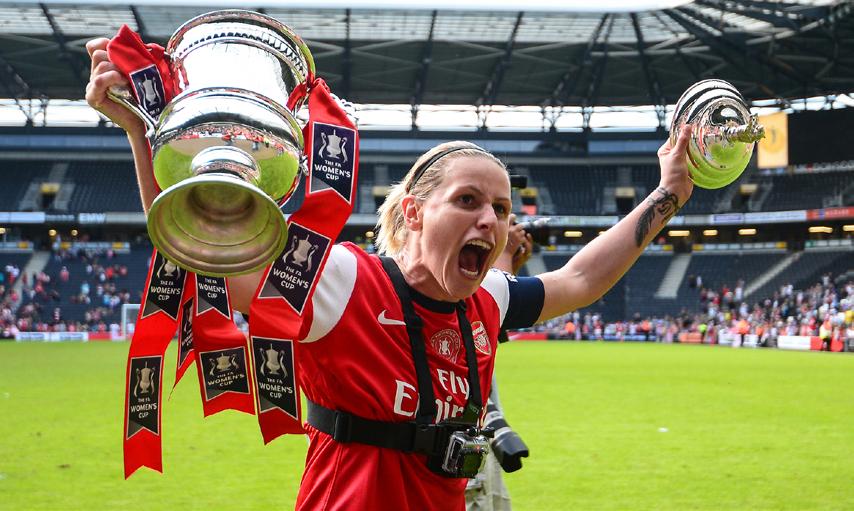





Lotte Wubben-Moy embodies everything I love about
Pickingfavourites is something I have always struggled with.
Whether it’s films, food or albums, I severely over analyse like my life is dependent on which choice I make and feel a strange sense of guilt for not selecting something else once I have come to a decision
Yet if I was asked who my favourite player for Arsenal Women is, I would not need to give it a second thought.
Lotte Wubben-Moy embodies everything I love about Arsenal and as the women’s team continue to grow exponentially, her role at the club becomes more and more important.
A childhood fan, Wubben-Moy knew from an early age what it meant to represent Arsenal, both on and off the pitch.


On the pitch, she is an outlet for fans’ love and passion, knowing better than anyone what those feelings entail.
Off the pitch, she is a true representative of Arsenal’s deep rooted community traditions, both working with Arsenal’s in-house charities alongside personal endeavours.
As part of a contract she signed back in 2022, Wubben-Moy pledged to work with Arsenal in the Community, creating the Time to Explore programme.
The programme is a combination of football and artistic pursuits for young girls from North and East London.
Saying: “The idea is for the girls to get stuck in, take themselves out of their comfort zone and see what puts a new and unexpected smile





on their face. From the start of the programme, it was important for me that attendance was free – no strings attached”
Away from Arsenal, she curated a free colouring book coinciding with both the 2023 World Cup and Euro 2022, with contributions from a wide variety of artists such as Jamie Hewlett of ‘Gorillaz’ fame.
Following the Lionesses’ Euros victory, she was crucial in the penning of an open letter to the government, campaigning that all girls are given opportunities to play football in school.
Instead of basking in the glory of that incredible achievement, Wubben-Moy used that victory to create a foundation for the next generation of girls in the sport to make sure that the hardships they could face in football are lessened.
Lotte is the perfect representative to anchor Arsenal Women’s exciting future at the forefront of women’s football in the UK whilst also symbolising Arsenal’s history and ethos that should be driving the club’s decision making.
As a fan, I feel deeply fortunate to have someone like Lotte at Arsenal, knowing the club will be in safe hands.

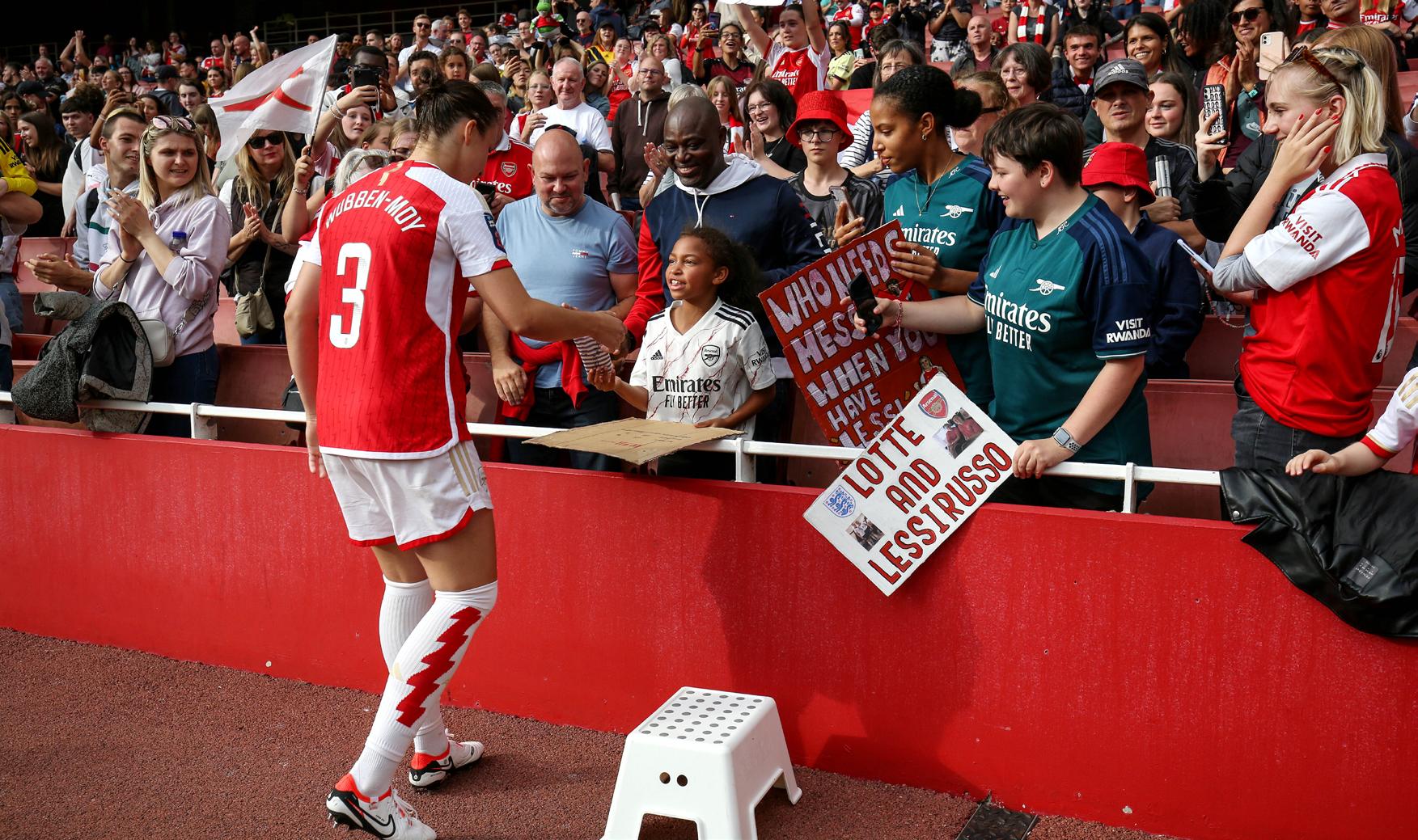




What could the future of Arsenal’s midfield look like asks Sophie Puodzius
Arsenal’s midfield contains an abundance of star quality, with a perfect blend of youth and experience resulting in fierce competition for starting roles.
However, the proficient Kim Little and Lia Walti have been plagued by injury problems whilst Victoria Pelova has suffered a devastating ACL rupture.
The growing need for greater rotation and minute management has meant that tough questions have been raised about the future of the Gunners’ midfield.
Arsenal’s double pivot has been a longstanding feature of their midfield, with Pelova establishing herself as a starter in this role.
In her absence, it’s expected that Kathrine Kuhl, Kyra Cooney-Cross, Little and Walti will rotate in these defensive midfield positions.
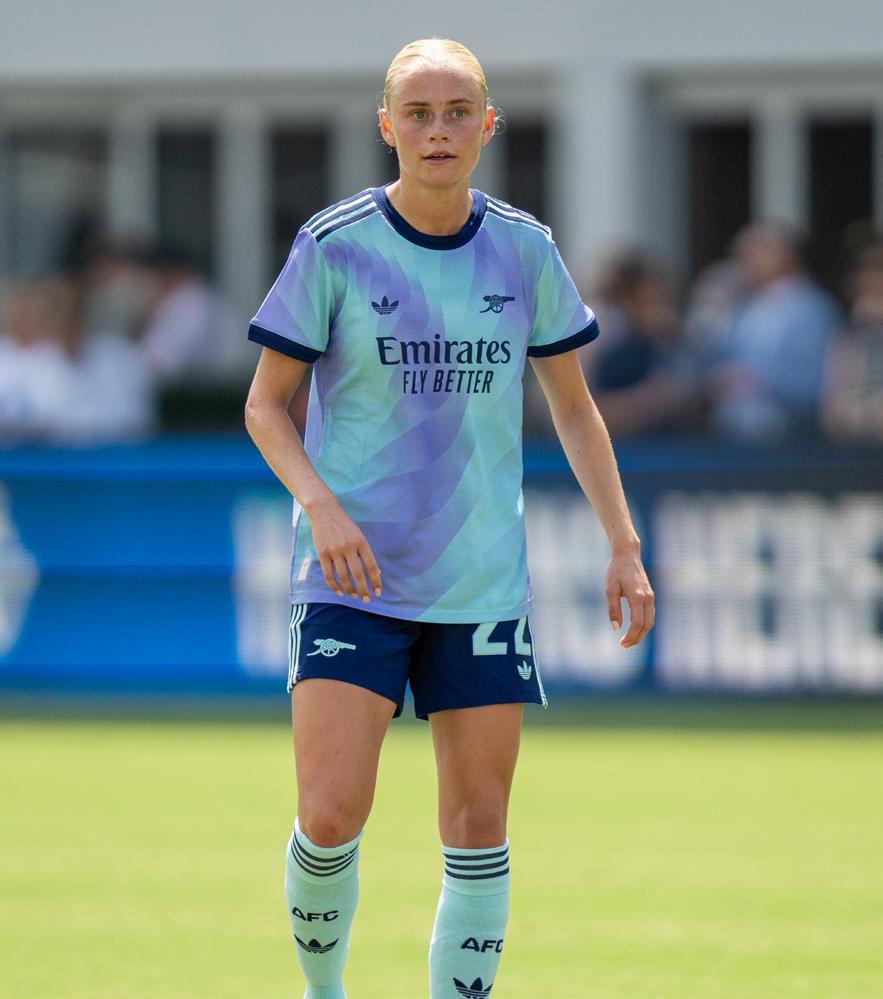



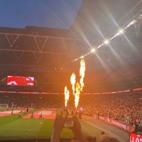

Sophie Puodzius @sophiepuodzius
Kuhl and Cooney-Cross could play a significant role in Arsenal’s title charge this season, with Kuhl returning from an impressive loan spell at Everton.
Her heightened confidence and awareness on the ball was exhibited throughout Arsenal’s pre-season, meaning that the 21-year-old could soon break into Jonas Eidevall’s starting eleven.
Meanwhile, Cooney-Cross saw more game time towards the conclusion of last season as her ability to connect the attack and defence allowed her to shine in this position.
The Australian superstar may play a crucial role in Arsenal’s season, due to her ability to break the lines of play and generate numerous attacking opportunities. This is vital when breaking down low blocks, as the youngster utilises her superb vision to pick out passes and drive the ball forwards.


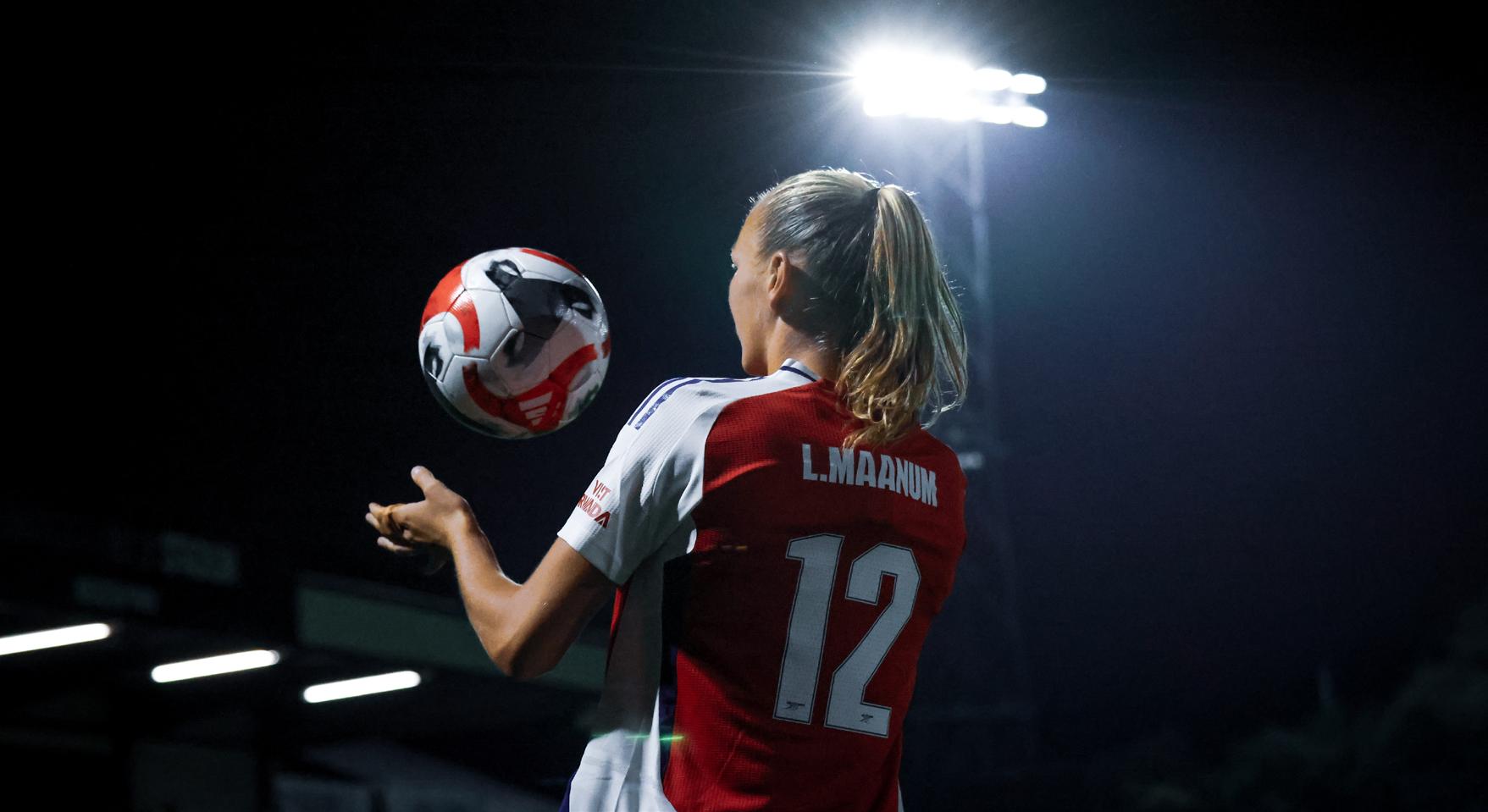
Since her highly-anticipated arrival in North London, Rosa Kafaji has been labelled as a standout player, owing to her technical abilities and creativity in the number ten role. She adds a distinct, ruthless edge in front of goal and brings a new level of intensity to Arsenal’s attack, therefore boosting her chances of becoming a regular starter.
Frida Maanum, Alessia Russo and Little are also capable of excelling in this playmaking role, giving Jonas Eidevall a surfeit of stellar midfielders to select from.
However, it’s unlikely that Little will frequently undertake the number ten position due to her ever increasingly important role as part of the double pivot.
If Arsenal’s routine 4-2-3-1 formation is deployed, then Russo could play in the number ten role behind Stina Blackstenius, as the attack-minded duo link up well to create goalscoring opportunities. Alternatively, Russo or Blackstenius could be utilised upfront with Kafaji and Maanum competing to start in attacking midfield.
Having such a wide array of midfield talent could be vital for Arsenal as they look to contest the WSL title and continue to progress into the latter stages of the UEFA Women’s Champions League.
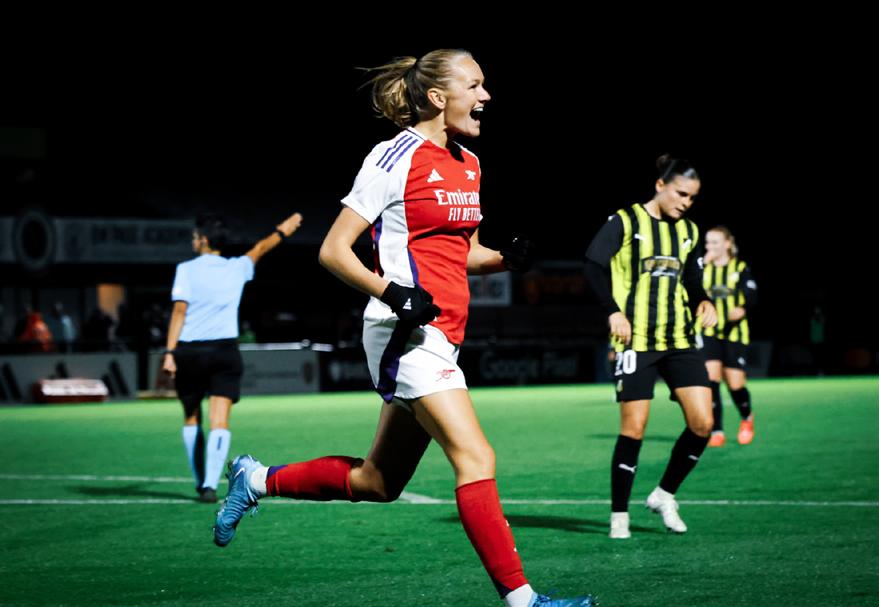





















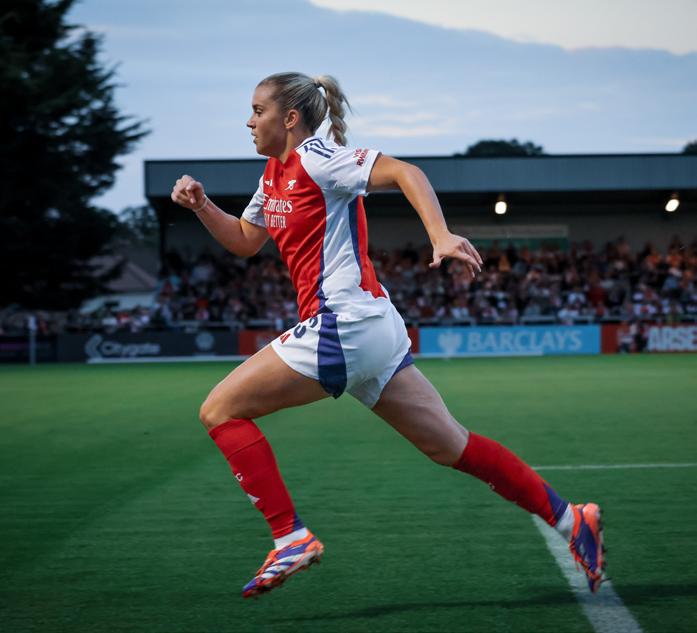










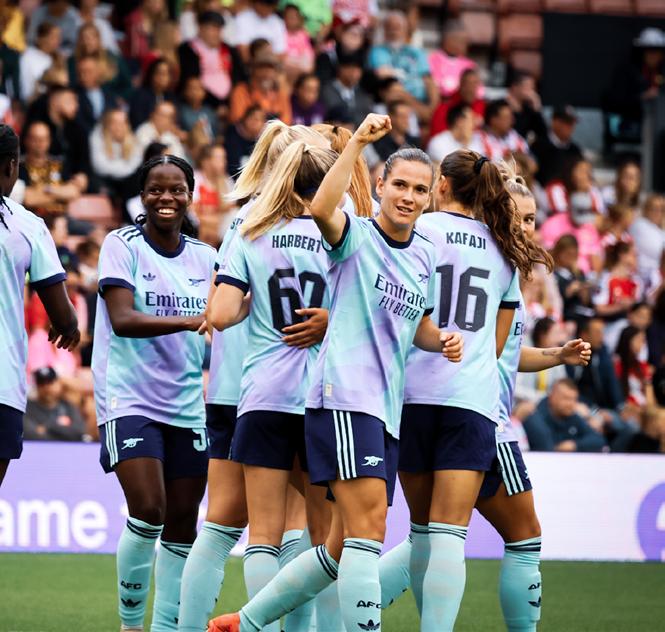



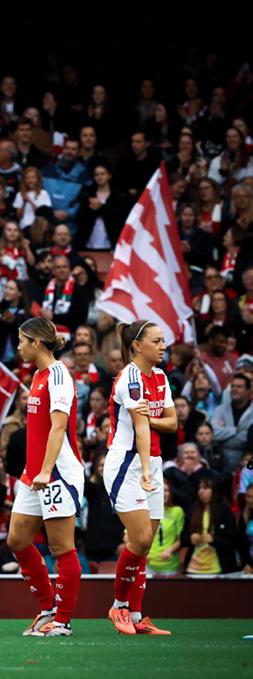




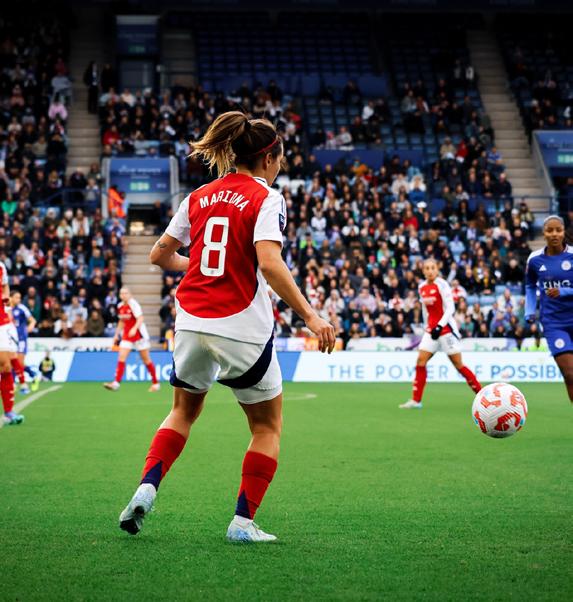


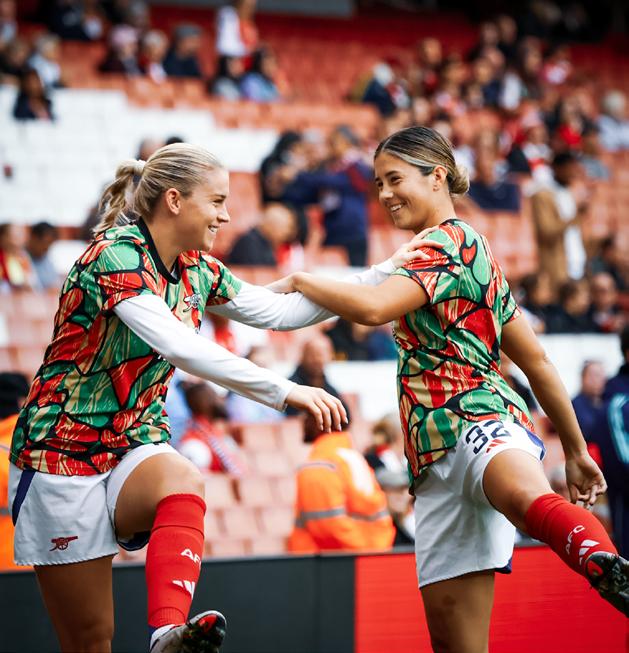

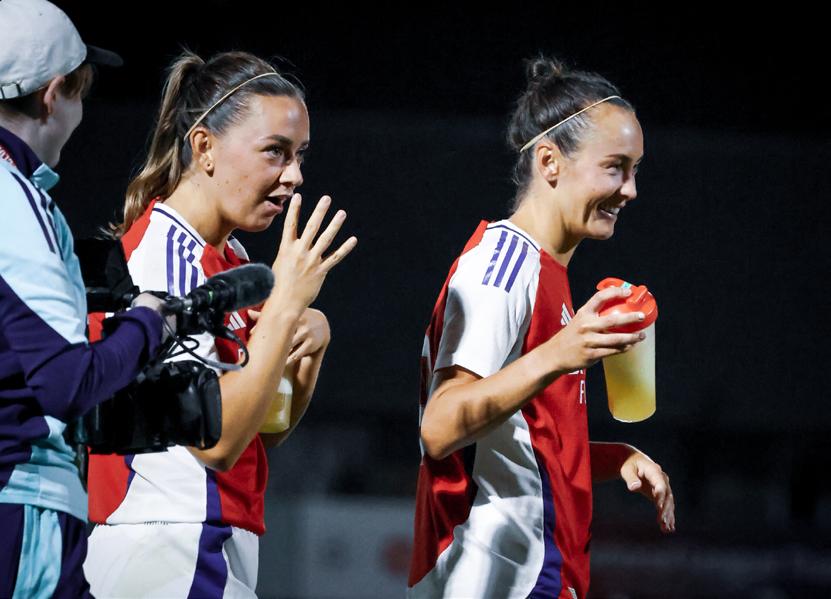










Arsenal Women Podcast: Pride Month Special
Claudia Loy joins Freddie Cardy to discuss a number of topics, starting with Rosa Kafaji and Daphne van Domselaar's signings, the departure of Gio Queiroz and what it means for Arsenal's starting lineup. They also commend Emily Fox's Olympic Gold and look forward to Arsenal's trip to Washington DC.

Daisy opens up on her experience in the women's game, the importance of LGBTQ+ representation and how the Arsenal and women's football community have created a positive environment for fans of all backgrounds to feel comfortable. The pair also discuss the work done by Gay Gooners, and further steps that need to be taken in football as a whole for LGBTQ+ fans and players.


Arsenal Women Podcast: Kafaji and van Domselaar sign, Fox wins Gold, US tour & Gio departs
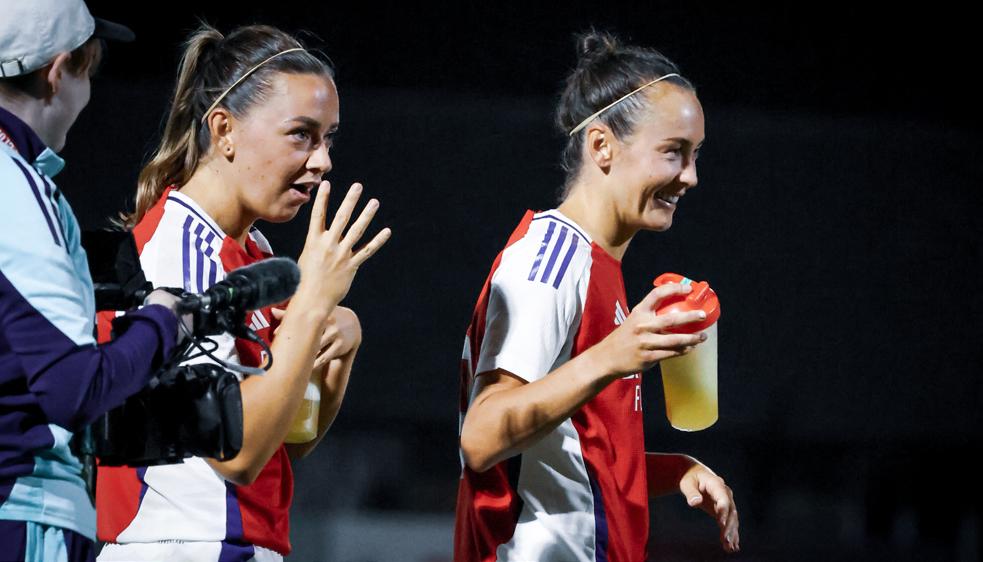
Arsenal Women Podcast: Caitlin Foord hits 4 as Arsenal thrash Rangers in Champions League qualifying



Freddie Cardy is joined by Daisy Goodhand to analyse Arsenal Women's 6-0 thrashing of Rangers in the first stage of UEFA Women's Champions League qualifying. The pair praise Caitlin Foord's 4-goal display, as well as discussing Mariona Caldentey's debut and looking ahead to Saturday's meeting with Rosenborg.


Subscribing to the 2024-25 season could not be easier. We understand times are tight. Which is why we are introducing a two tier subscription system.
If you can afford to pay what the Gooner Fanzine should actually cost for a season, which is £45, then we have set up a Gooner Gold Subscription in which you’ll get all six print issues of course, but also free access to our digital edition and your name in print in our forthcoming ‘Hall of Fame’ in every issue next season.
However, if you can’t stretch to £45, or you simply feel that £30 (eight pence a day) is what you would like to continue to pay, then we have our Gooner Standard Subscription - with which you’ll receive six issues.
Please note, if you have already rolled over your direct debit (thank you!) but would like to upgrade to our Gooner Gold Subscription then simply pay the £15 difference to our PayPal (thegoonerfanzine@btinternet.com) account and we’ll amend your level accordingly.
So, to recap, here are the two options
United Kingdom:
Gooner Gold Subscription £45 – includes access to our digital edition (gift it to a friend) and your name in print in our forthcoming Gooner Fanzine Hall of Fame
Gooner Standard Subscription £30 - for those on a budget - price frozen for yet another season
Rest of the World:
Gooner Gold Subscription: £65
Standard Subscription: £49 - for those on a budget - price frozen for yet another year
All payment options are available through our online shop at WWW.ONLINEGOONER.CO.UK
Account Name: Gooner Publishing
Account Number: 24354295
Sort Code: 60-11-10
We know that online banking isn’t for everybody so we will be able to accept cheques again this year
Cheques should be made payable to ‘Gooner Publishing’ and posted to:
Gooner Publishing, Paynes Park House, Paynes Park, Hitchin, SG5 1EH.
Please enclose a note with your full name, address, phone number and Email address or use the template template below. As with previous years, cheques won’t be cashed until we reach our target 1000 UK subscribers. If we fail to reach our target, cheques will be destroyed. Please do not send cash!


NAME ADDRESS
Yes please sign me up for the 2024-25 Gooner Gold subscription at £45 to help ensure our future I’m happy with the standard subscription at £30 to help Save the Gooner
EMAIL ADDRESS (for digital editions)
We will accept a photocopy of this form if you do not want to cut this page out of your Gooner. Or simply send a cheque for £30 or £45 to the address above with you full name, address and postcode.
Or visit our online shop at www.onlinegooner.co.uk


For just £20 annually, you can be a voice in making Arsenal a stronger club with true custodian values.
You can attend meetings with guests including representatives from the club, football experts and leading journalists. You’ll get the latest news on all supporters issues at Arsenal and a full overview on club finances.
The most important poart? You’ll be a voice that is actually heard by the club. Our surveys, meetings and feedback forms give you a direct input to the Fans’ Forum and Advisory Board.
The proof is in what we have already done:
Helping to stop the European ‘Super League’
Securing Government support for independent regulation of English Football. Safe-standing to be introduced at the Emirates Stadium for match-going fans, including facilities and atmosphere.
More than £45,000 raised for the Arsenal Foundation and Islington charities.
And we won’t stop there. Be a part of the club and its future. Be more than a fan.
To join the AST from £20 a year, go to: www.arsenaltrust.org/join


